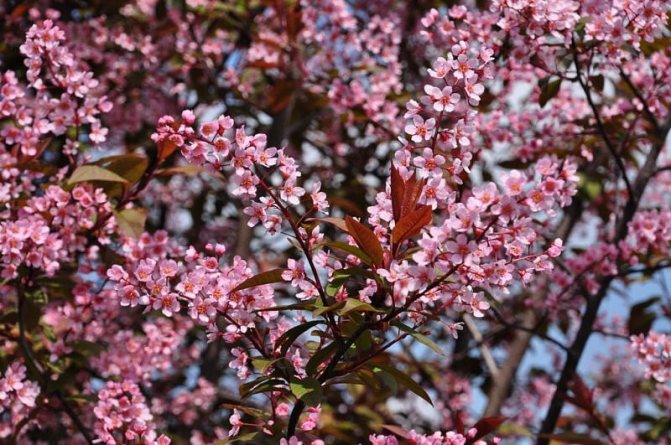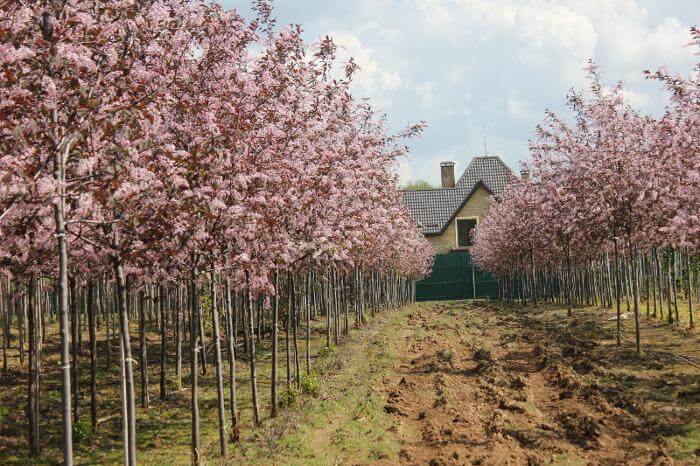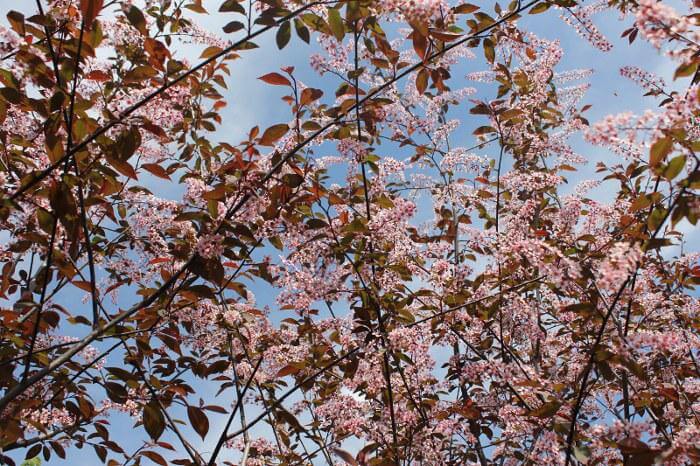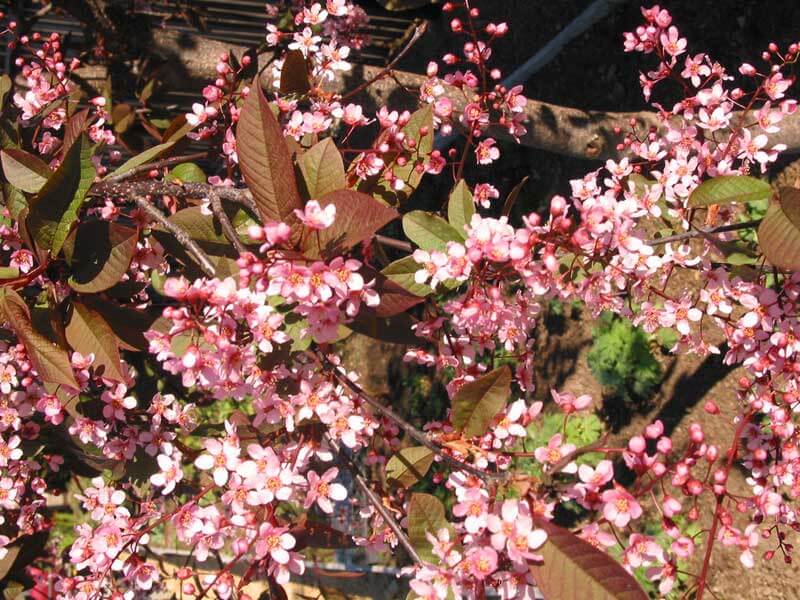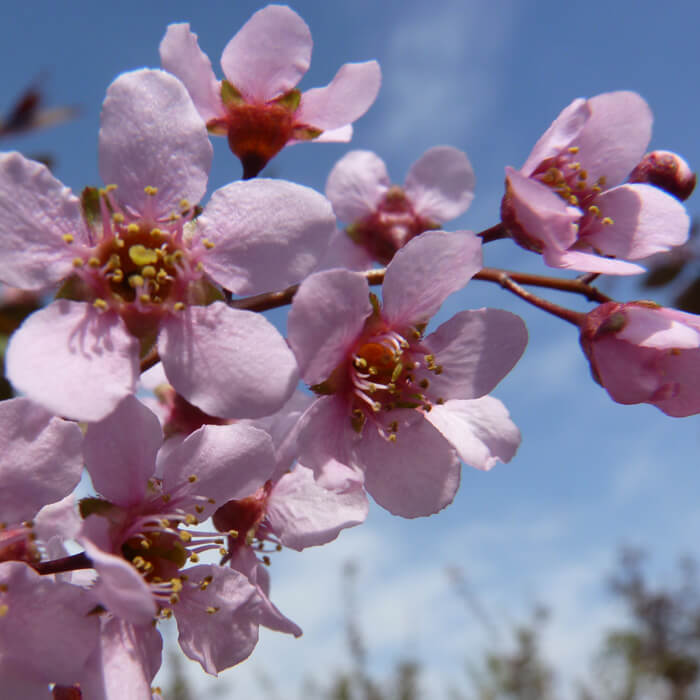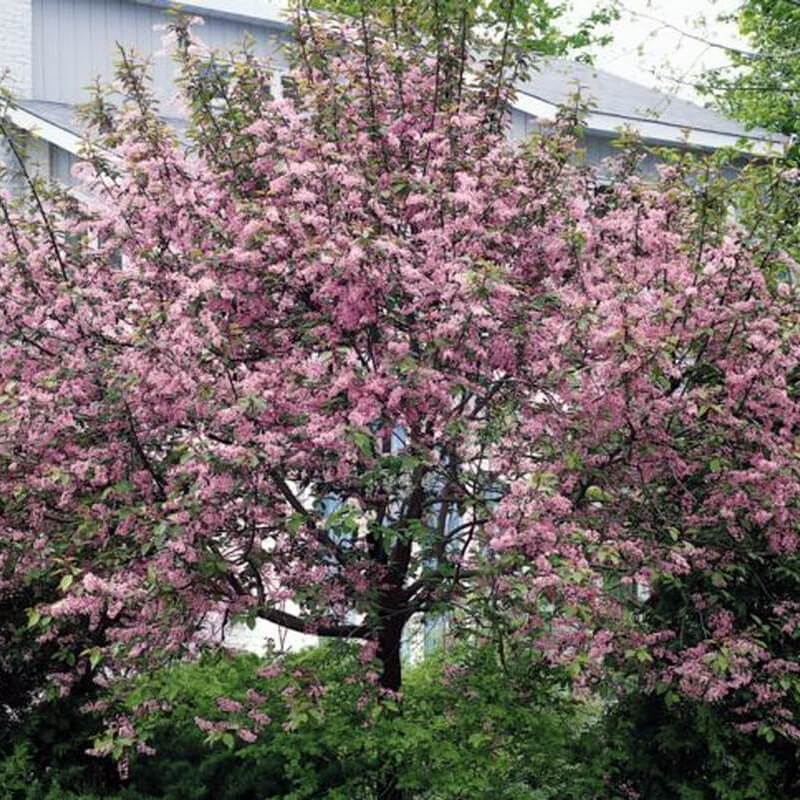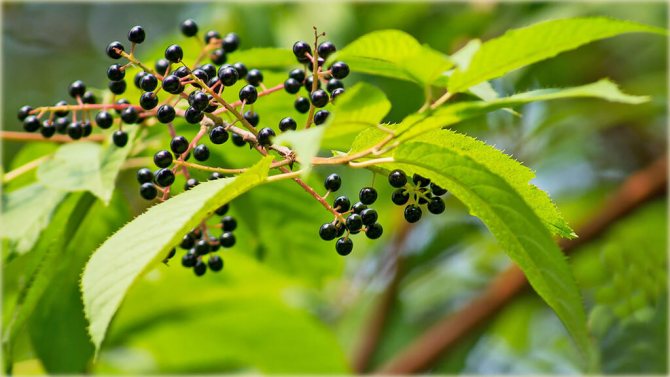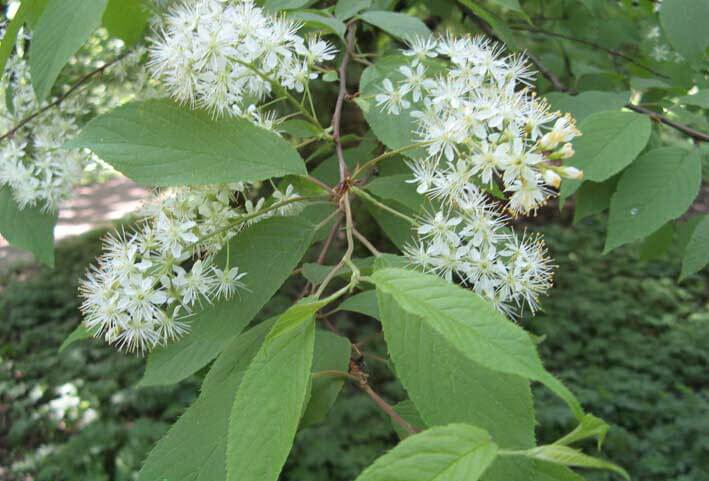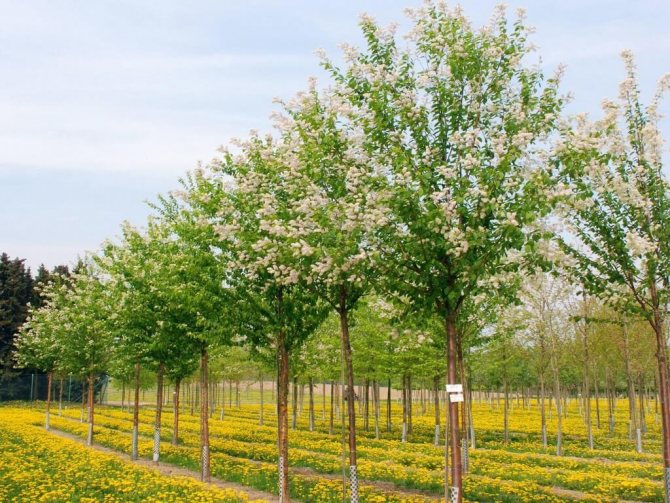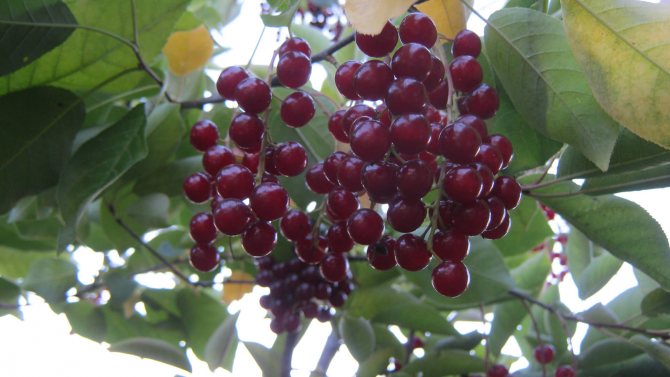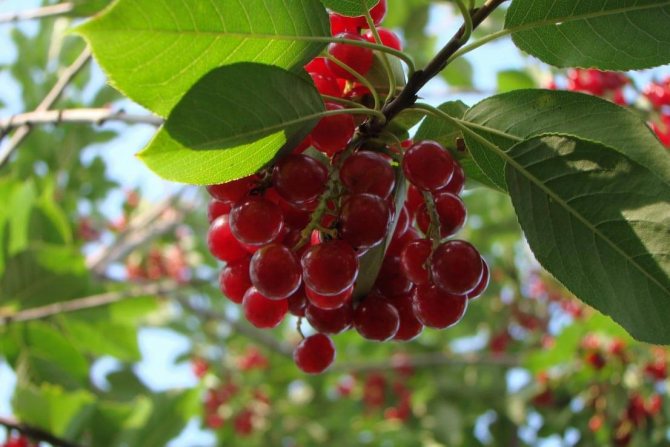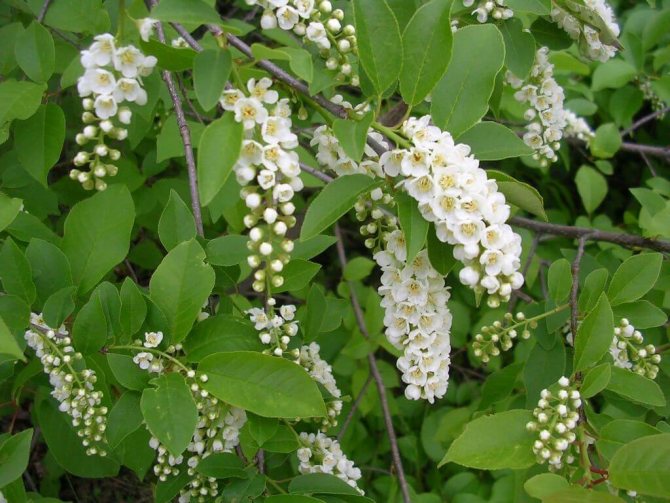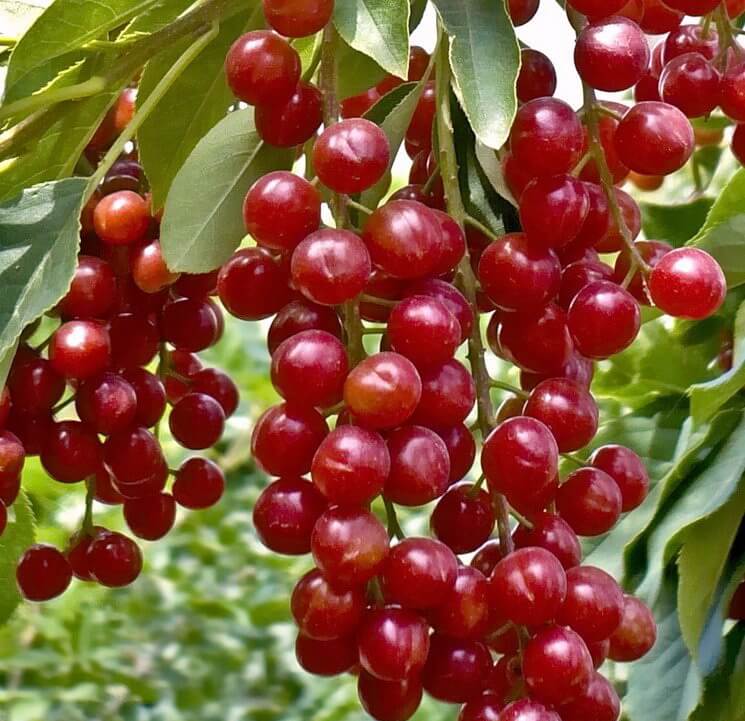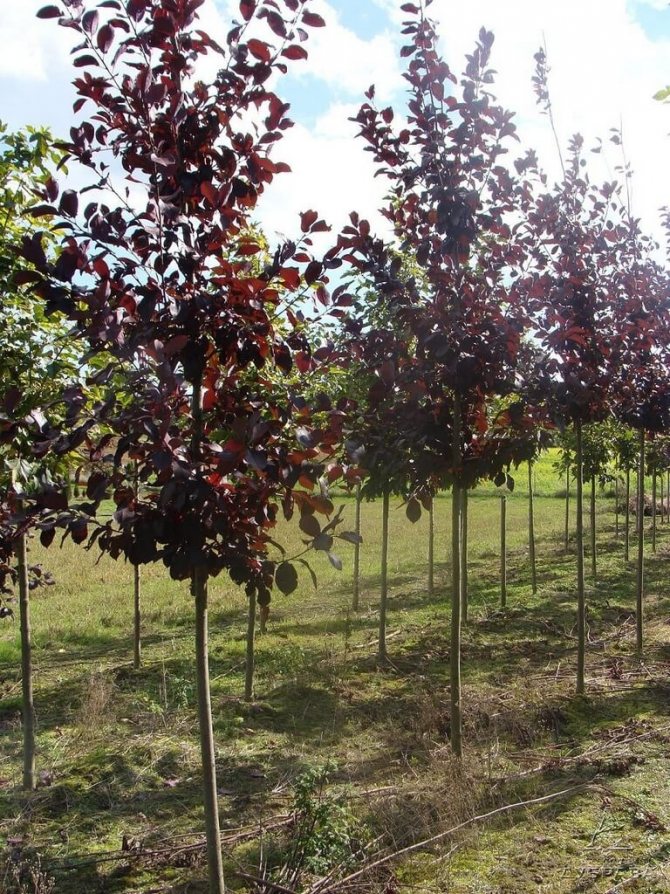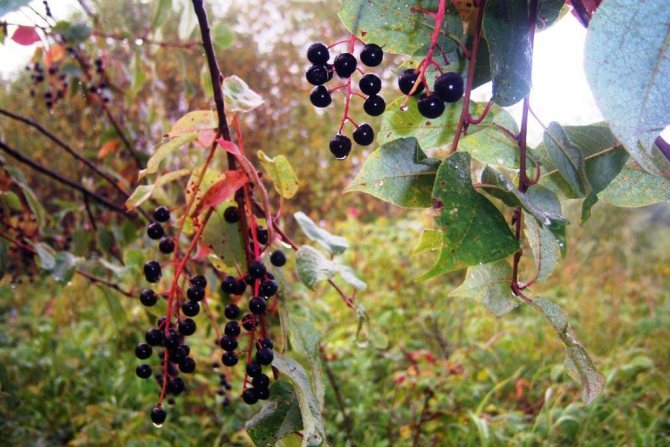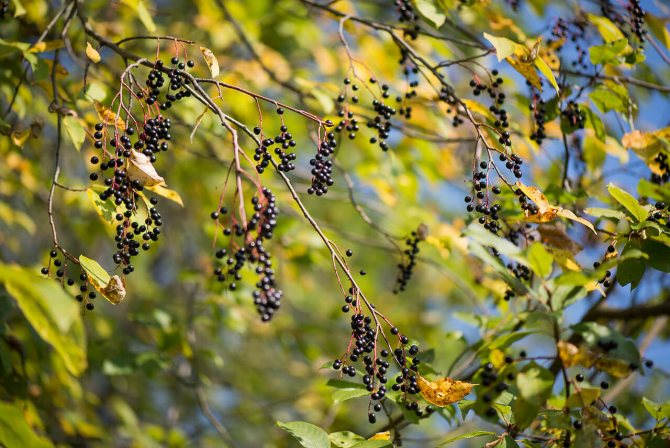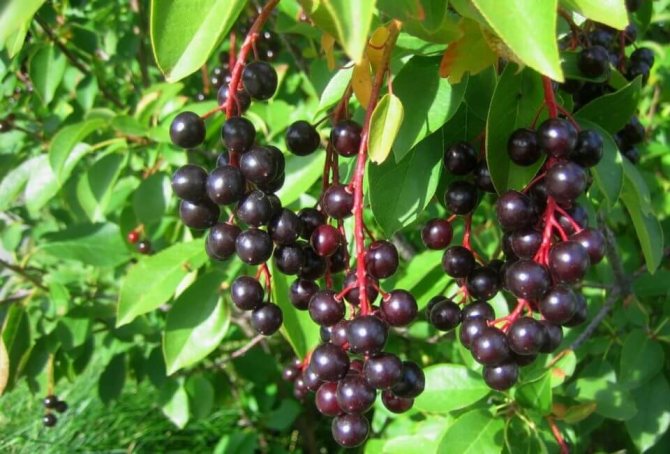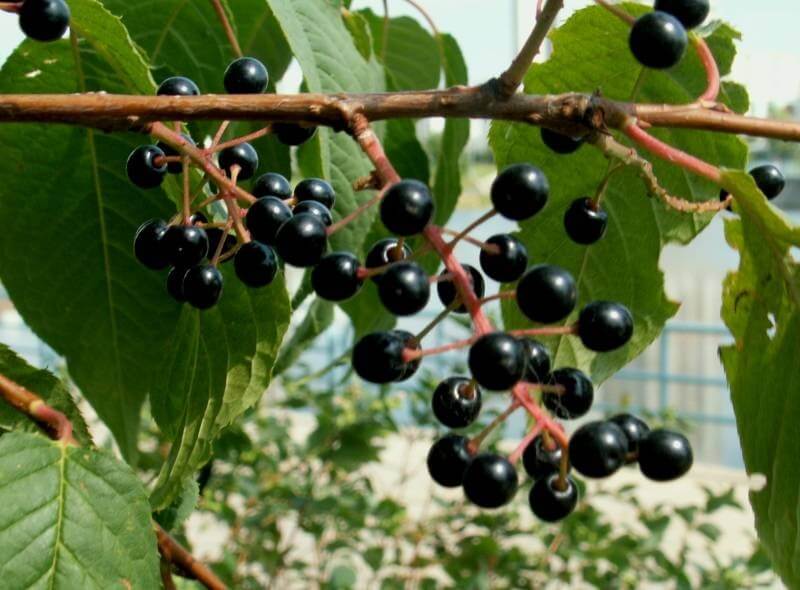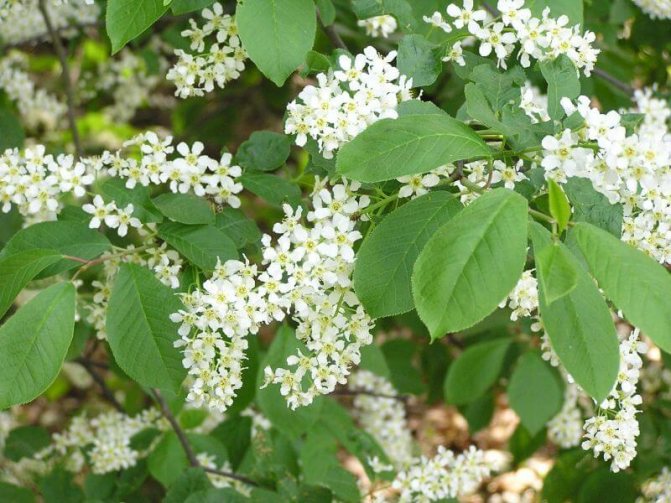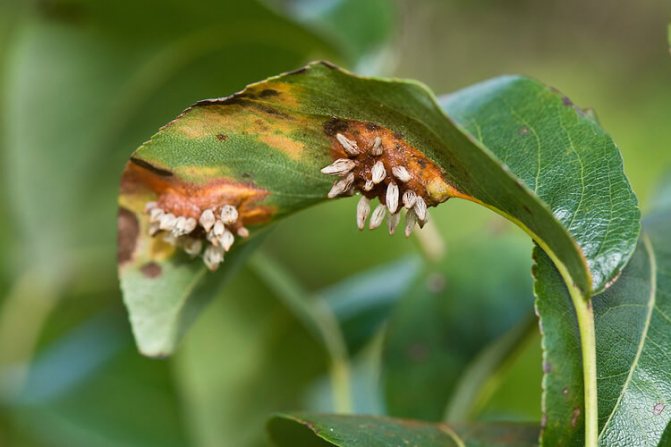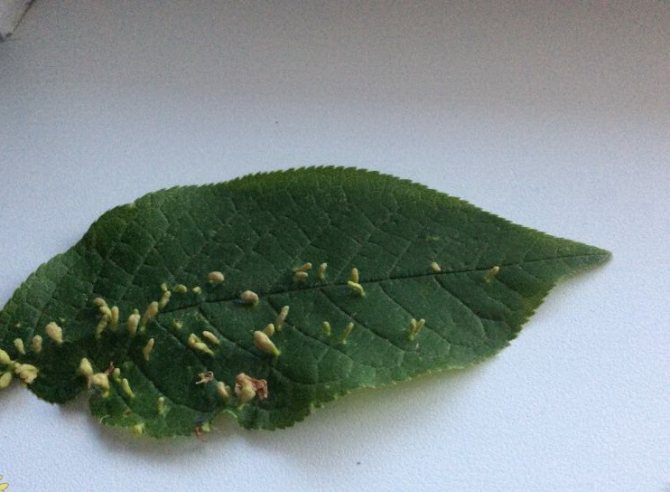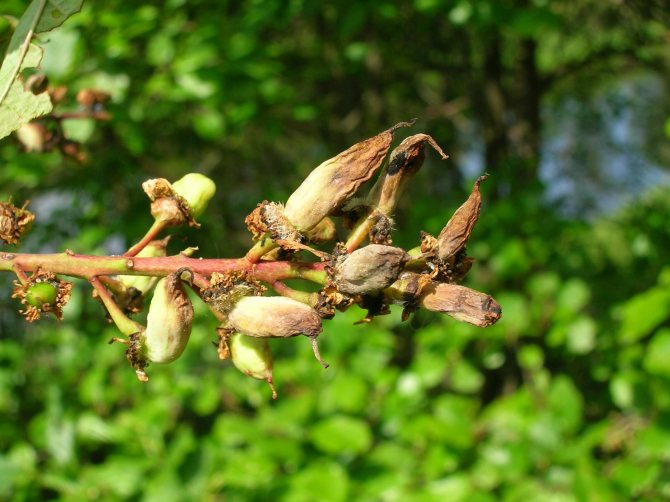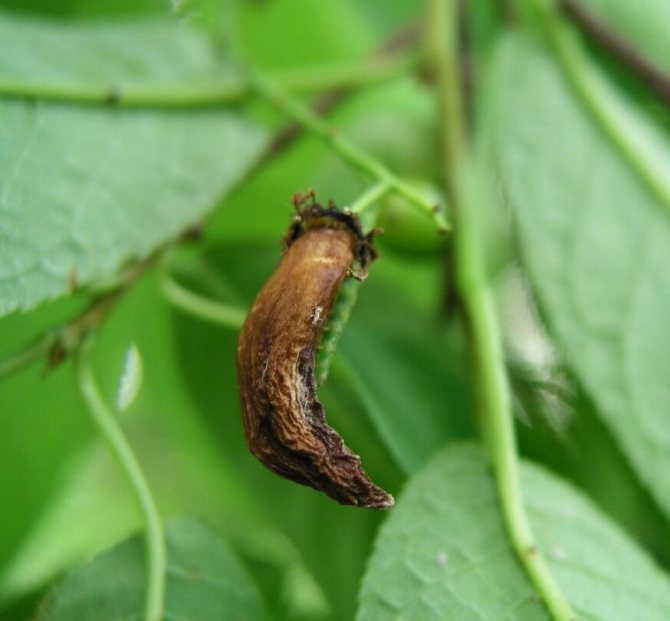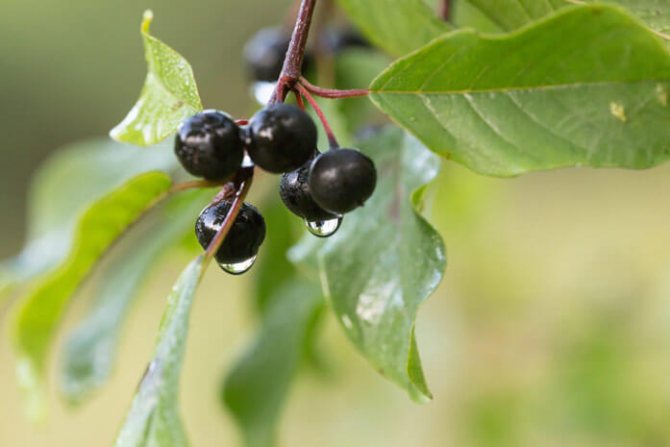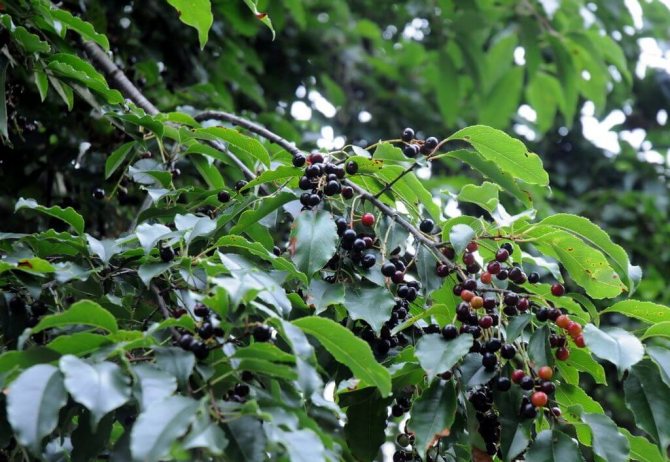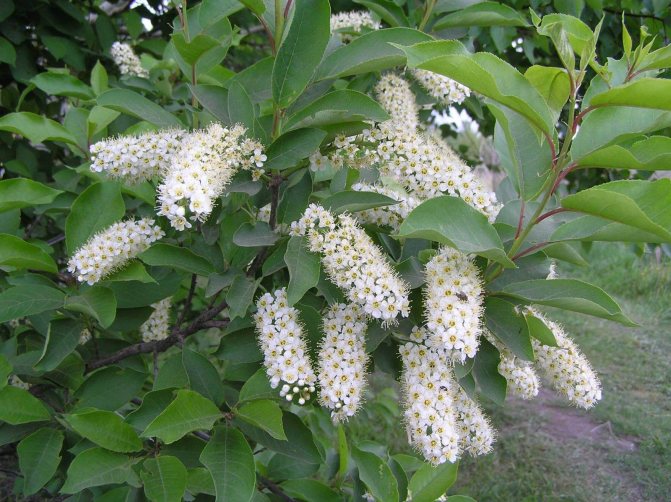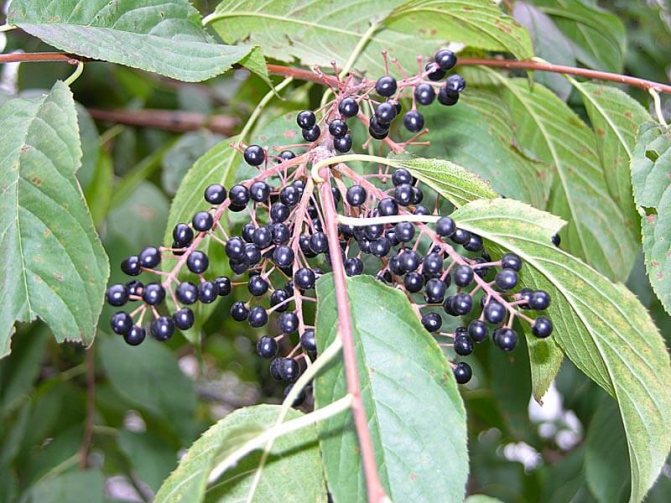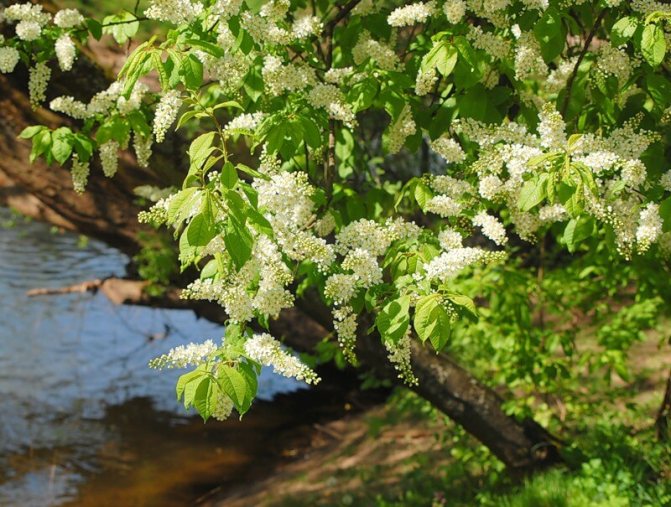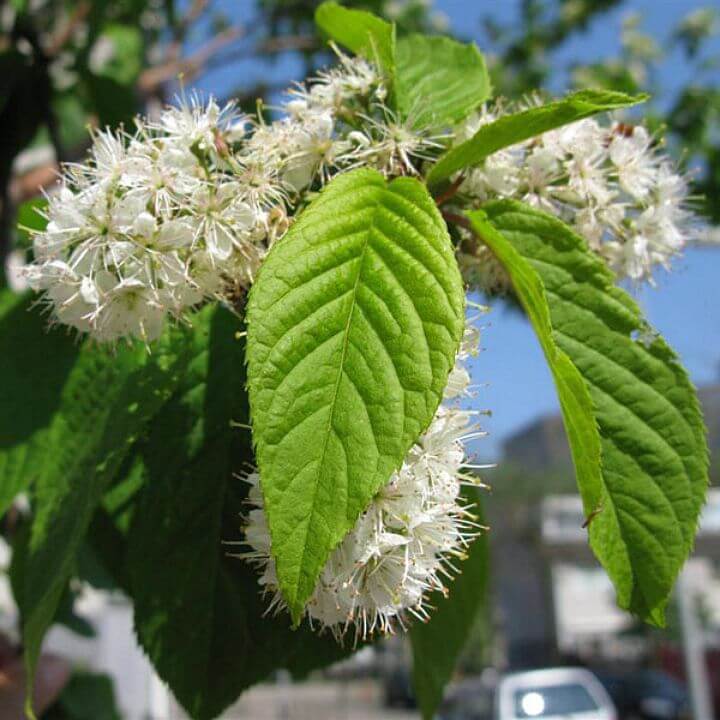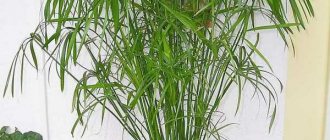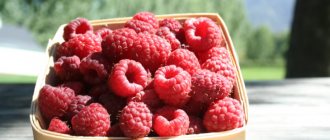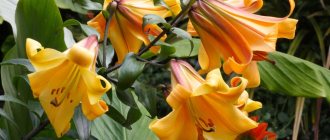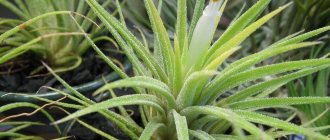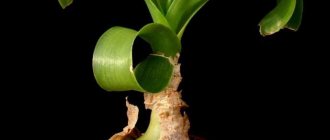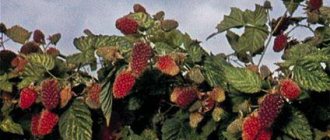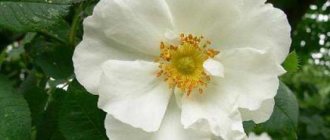There are many people in the world who dream of having their own garden - a place full of beautiful greenery, where you can feel like you are in nature, even when you are in the middle of civilization. For some lucky ones, this dream has come true, and they are happy to plant a variety of plants in their gardens, from tiny flowers to large trees. This article will tell you about one of them, especially beautiful and mesmerizing - bird cherry. About what varieties of this plant exist, how to plant it correctly and how to take care of it later, you can find out below.
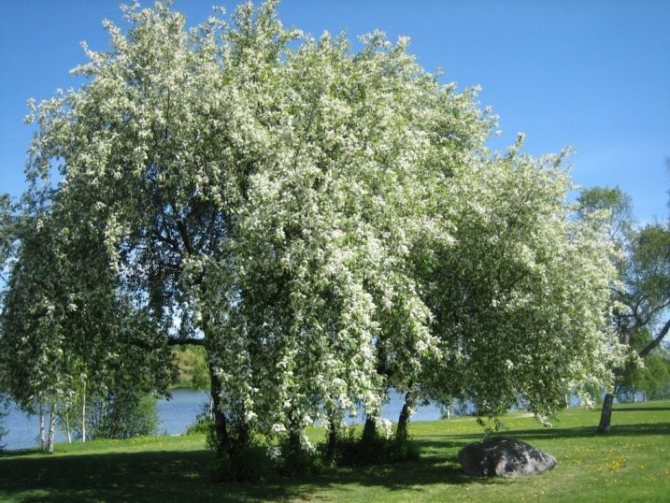
How to plant bird cherry


You can plant a tree both in early spring and in autumn. Both options are effective if you follow some guidelines. One of the most important is the choice of location. Bird cherry prefers wetter soils. Therefore, if there is a lowland on the site, then this site will become optimal for a tree.
It is important to remember that the plant loves a lot of light. In the shade, the bird cherry will stretch, as a result of which the inflorescences will begin to form only at the tops.
Planting bird cherry in the fall
Planting trees is best done at the end of September or October. At this time, the soil is most saturated with moisture, which will help the seedling to take root faster.
The pit is prepared in several stages. First, 7 cm of loose soil is laid on the bottom of the recess. Then sprinkle with 5 cm sawdust and 20 cm of moist soil. Each layer should be watered abundantly with water. Then make a small mound on which to place the seedling. Sprinkle with fertile soil and water lightly.
Planting bird cherry in spring
The landing site is prepared in advance. Before the onset of frost, you will need to dig a hole, the dimensions of which will be slightly larger than the root system itself. Place a small amount of mullein at the bottom of the groove. Leave in this state until spring.
With the onset of heat, dig up the contents of the pit and sprinkle it with a thin layer of fertile soil. Then place the stalk in the middle, straightening the roots well. Sprinkle with soil and cover thoroughly with water. Lay a layer of mulch on top. It can be sawdust, peat, dry leaves or straw.
An excess of organic matter negatively affects the color of the bark and the development of branches. Shoots become very thin.
How much does a bird cherry need sunlight
Many gardeners will confirm the widespread belief that bird cherry does not need sunlight as much as most other similar plants. This theory is supported by the fact that, even being in the shade during its entire growth, the bird cherry does not experience any special problems, but on the contrary, it blooms and grows, and without any additional feeding. There is, however, the opposite opinion. Some summer residents will say with confidence that the shadow bird cherry in some way does not reach the beauty of the tree that grew under the sun. However, this opinion is not particularly popular, and the type of tree depends not only on external factors, but also on the characteristics of a particular plant.
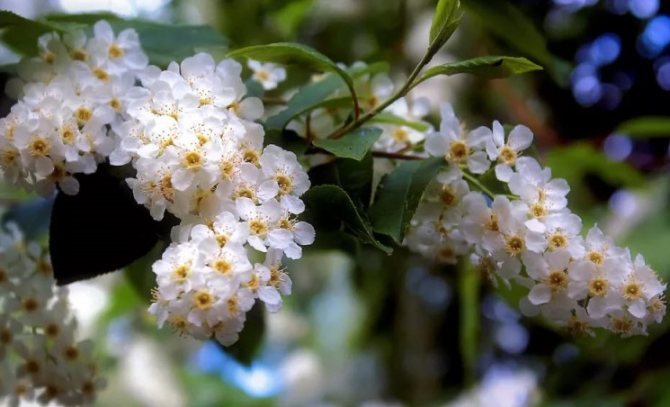

Bird cherry cultivation and care
The cultivation of bird cherry does not require much attention. The tree is quite unpretentious to care for. To make the plant beautiful and decorate the site, it is enough to adhere to watering, fertilizing, pruning.
Irrigation of bird cherry
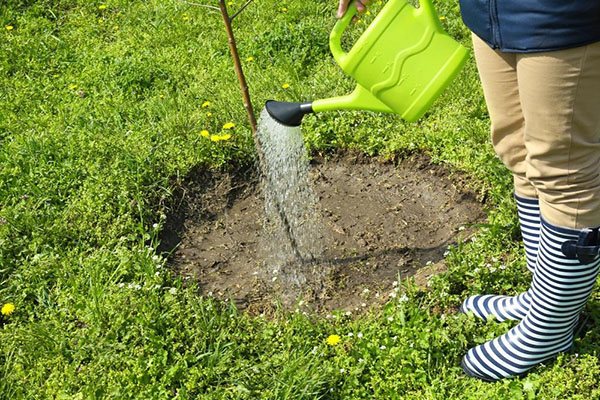

Watering young trees is necessary only at the root. The procedure is carried out 2 times a month. Pour from 20 to 30 liters of liquid under each copy. If the weather is dry and hot for a long time outside, then you can additionally spray the twigs with warm, clean water. This should be done only late at night.
Daytime spraying can lead to burns on the surface of the leaves.
Fertilizing bird cherry
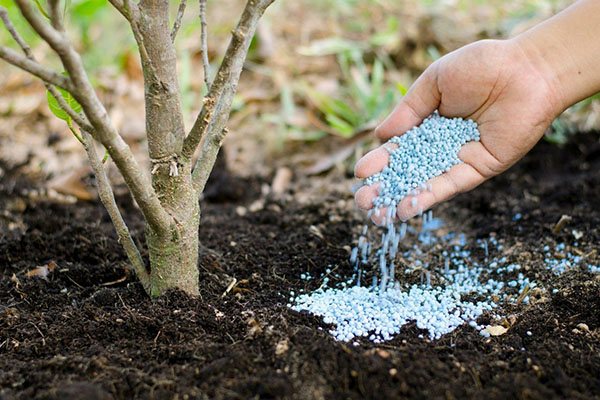

It is not necessary to feed the tree, but if you want it to grow faster and begin to bloom, then you need to periodically add nutrient mixtures.
Using top dressing, bird cherry will hurt less.
The plant is well influenced by mineral and organic preparations. They are brought in both in the spring and with the onset of autumn. In April, when the soil warms up well under the sun, bird cherry is fertilized with urea or saltpeter. In autumn, it is best to add superphosphate or potassium salt to the soil.
It is recommended to apply the mixture only at the root. Carrying out such a procedure, it is necessary to ensure that the funds do not fall on the leaves and young shoots.
Pruning bird cherry in spring
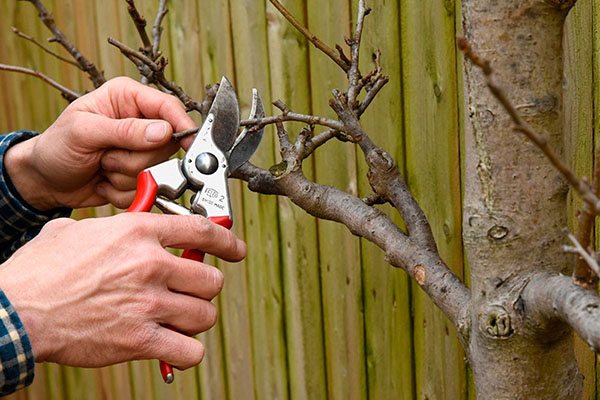

This is as important a procedure as irrigation and fertilization. Pruning is carried out after careful examination of the tree. All deformed, dry twigs, as well as unnecessary growths, should be removed.
Formative pruning is carried out in the spring. To give the tree a beautiful look, it is necessary to leave the branches symmetrically located to each other. The first tier is cut at a height of 70 to 80 cm. As soon as new shoots appear, it is recommended to leave the most developed ones.
To form a standard tree, it is necessary to cut off all the lower shoots.
Follow-up care
Red-leaved bird cherry in the dry season must be watered weekly, especially for young plants. The near-stem circle is periodically loosened, removing weeds. Saplings with a thin main trunk are best tied to a support, which will prevent them from breaking off from strong gusts of wind. In the fall, wood ash and manure are introduced into the soil; in the spring, before bud break, bird cherry is fed with liquid mineral fertilizer.
Due to the fast growth rate, all varieties of red-leaved bird cherry need formative pruning. Once a year (in early spring before the start of sap flow or in late autumn), the main shoot is shortened by 50 cm, branches growing inside the crown, as well as dry and damaged fragments, are removed. Places of cuts are treated with garden varnish.
To protect against rodents, sawdust, peat or ash dipped in creolin are scattered under the tree. For the same purposes, in late autumn, after the end of leaf fall, the trunk is tied with spruce branches, wormwood or reeds. It is no less effective to wrap the base of the tree with tar paper, matting or metal mesh.
Red-leaved bird cherry is a frost-resistant culture that does not require shelter for the winter. Only in the first year after planting, it is advisable to cover the peri-stem circle with a layer of humus or cow dung, it will not allow the roots to freeze.
Bird cherry propagation
It is not difficult to grow a new plant on your site. Several methods can be used for this. If you adhere to all the recommendations, then everyone can get the desired result.
How to grow a bird cherry from a stone
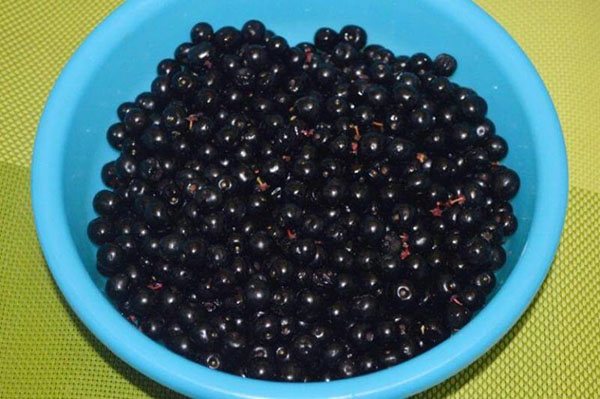

For propagation, it is recommended to use only overripe berries. The bones must be stratified before planting. This will help increase seed germination. For this, the planting material is placed in wet sand, and the container itself is placed in a cold place. The bottom shelf of the refrigerator is optimal. It should be kept in this state for about 3 months. Then the grains can be sown in a nutritious soil. Cover the flowerpots with transparent polyethylene. As soon as the first shoots appear, the seedlings will need to be opened.
Transplanting young plants into open ground is carried out in the second year after germination.A dimple for the seedlings is dug out of such a size that the roots can be well straightened. Put a small amount of mineral fertilizer on the bottom of the groove. Then cover with soil, water abundantly. Cover the soil around the plant with mulch.
How to plant bird cherry cuttings


This is the fastest and most efficient breeding method. Cut off the cuttings from adult branches. The length of the planting material should be from 10 to 15 cm. It is recommended to separate the cuttings on a cloudy day or early in the morning, before sunrise.
It is necessary to remove leaves from all planting material, leave only a couple at the top. Then put it in water or in a special solution for a day. At the end of this time, transplant the cuttings into a nutrient substrate that allows moisture and air to pass through well. Cover the container with bird cherry with polyethylene or glass. Water the cuttings as needed.
If everything is done correctly, then closer to autumn they take root well. In September, plants can be transplanted into open ground.
Reproduction by root shoots
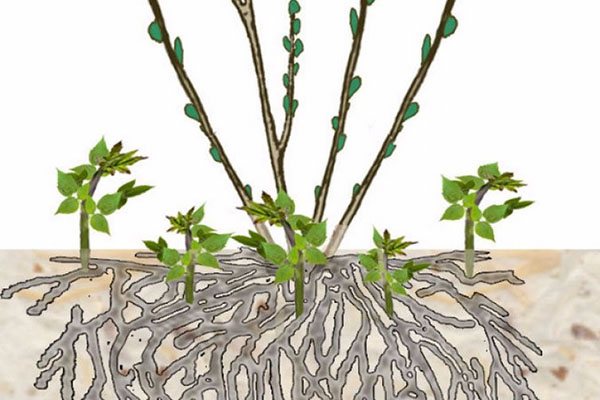

This method is best used for Verginsky bird cherry. This variety forms shoots most of all. In order for the planting material to better take root in a new place, it is necessary to separate it from the main bush in the spring. Closer to autumn, the shoots can already be transplanted to a permanent place.
Reproduction by grafting
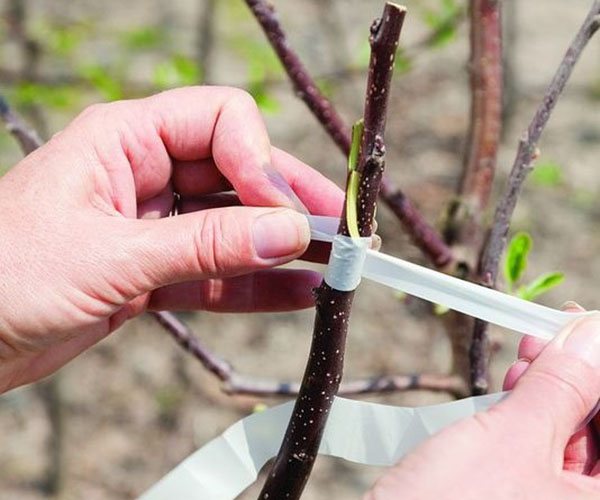

This method is carried out in early spring or winter. You can use both copulation and budding. Seedlings of common bird cherry are used as a stock. When copulating, cuttings and buds take root by 98%.
It is not difficult to care for such plants. The main thing is to systematically water the bird cherry, loosen the soil and apply fertilizers on time.
Reproduction by layering
Rooting holes must be dug in the spring. Their depth should be from 10 to 12 cm. Place the layering in the middle and fix it carefully with metal brackets. Hilling planting material should be 1/3. Layers should be separated in the fall. To do this, use a bayonet shovel.
Willow pruning
Dead branches are cut off from a willow tree, a crown and a stem are formed. Remove very long shoots on the lower part of the trunk. Plants tolerate shearing well, if it is not a weeping form. Older copies can be trimmed "to the stump".
On a note: It should be remembered that the bark and leaves of this plant contain a lot of tannins that inhibit plant growth, so the fallen leaves should not be used for composting, it is advisable to collect them in late autumn or early spring and burn them. You can spread foliage along the fence from the outside - there will be less grass.
Bird cherry ordinary: description
The first mention of bird cherry dates back to the time of the ancient Greek scientist Theophrastus. Bird cherry is known far beyond the borders of our state. So, for example, in Africa, Asia and Europe, it is considered one of the most attractive plants, excellent for decorating areas.
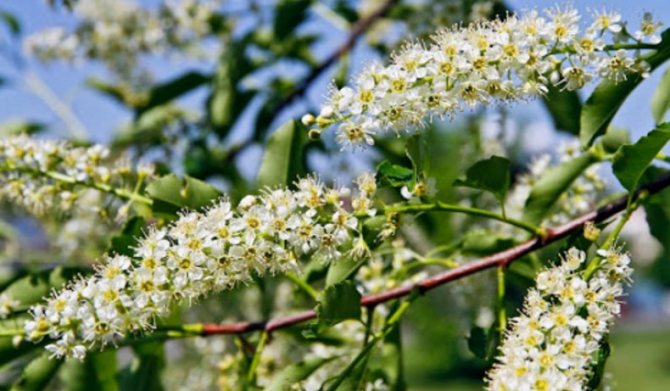

The tree begins to bloom actively in April-May, dissolving white fragrant brushes. The inflorescences and fruits of bird cherry are small in size, but at the same time they are extremely nutritious and saturated with sugar compounds and glycosides. Bird cherry is filled with useful properties and substances, due to which, in one form or another, it is often used in medicine and cosmetology.
Where the bird cherry grows is important.
This plant loves constant moisture.
In the wild, bird cherry can be found in the temperate zone. It grows in dense forests, in wetlands or on the banks of rivers. It is noteworthy that in conditions of proper care and proper planting, bird cherry can be planted in any summer cottage and personal plot of our country.
Bird cherry is a bush or tree that can reach a height of 10-15 meters. The diameter of the bird cherry crown can reach 5-7 meters.This plant is very unpretentious, which allows it to grow on any soil, regardless of its composition and acidity level. In some cases, bird cherry can also be found on sandy soil.
The tree has a massive, rapidly growing root system. It is thanks to these properties people often planted bird cherry to create natural drainage of the land near the dwelling. Moreover, bird cherry is capable of ennobling the soil, and its falling foliage can reduce acidity and increase the yield of the land.
Bird cherry tree - description
Bird cherry is a small tree or shrub with a height of 60 cm to 10 m with a dense, elongated crown, and black-gray matte bark with white lenticels. Young branches and shoots of cherry or olive shades of bird cherry. Leaves are glabrous, alternate, simple, elliptical, oblong, serrate along the edge, with a pointed apex, from 3 to 15 cm long. On thin petioles, at the base of the leaf plate there are two glands. Fragrant flowers of bird cherry - white, sometimes pinkish - are collected in drooping carpal inflorescences 8-12 cm long. Flowers consist of 5 sepals, 5 petals, 20 stamens, pistil and yellow anthers. The fruit of the bird cherry is a black spherical drupe with a diameter of 8-10 mm with a sweet, strongly astringent taste. Inside the berry there is a rounded ovoid bone. The bird cherry blossoms in May-June, and the fruits ripen in July-August.
Choosing a place for planting bird cherry
Without exaggeration, the choice of a site for planting bird cherry can be considered one of the most important stages that predetermines the result of further tree growth. That is why you should carefully follow the recommendations based on the preferences of bird cherry regarding illumination and soil quality.
How much does a bird cherry need sunlight
Due to the large size of the bird cherry, for proper growth and sufficient nutrition, it must receive a large amount of sunlight.
Thus, it is advisable to plant a tree in well-lit areas.
What kind of soil does bird cherry love
This plant is quite unpretentious and can withstand growing in poor quality soil, even in spite of the general acidity. but bird cherry takes root better and grows faster in loose, nutritious soil with a moderate level of moisture
... To do this, before planting, it is worth treating the soil, and after planting, ensure timely regular watering.
Virginia bird cherry
In their natural environment, representatives of the species live in North America. The tree develops up to 15 meters in height, sometimes it is represented by a medium-sized shrub, about 5 meters high. The plant blooms in late spring, the aroma is not felt. The fruits of the tree are reddish in color, about 0.5-0.8 cm in diameter, and can be eaten. The inflorescences are white, the foliage of the plant is reddish-burgundy. The tree is resistant to low temperatures and hot dry weather, but needs lighting and watering. This species is divided into several forms, which differ in the color of the fruit (yellowish, black and cherry). The tree may be low or have drooping branches.
Interesting varieties of Virginia bird cherry:
- nana - undersized bush;
- pendula - a plant with a weeping crown;
- rubra - cherry-colored fruits;
- xanthocarpa - yellowish fruits;
- melanocarpa - black fruits.


The basics of planting bird cherry in the garden
The pickiness of the bird cherry in the care and cultivation process in many ways seduces people, but the end result is determined precisely at the planting stage. Errors and inaccuracies can be fatal to the seedling. In order to properly plant bird cherry in the spring,
during the main stages of preparation and disembarkation, it is strongly recommended to follow simple but effective recommendations.
How to properly prepare a planting hole for a seedling
The preparation of the landing pit is carried out in several stages. Its dimensions must be at least 50 × 50 × 50 centimeters.
This is due to the rapid development of the root system of the tree, the soil around which must be fertilized and loosened, which is done during the preparation process. The dug hole is watered abundantly, after which it should be covered in layers in the following order: loose earth (5-7 cm), sawdust (3-5 cm), loose earth (15-20 cm). After each subsequent layer, it is advisable to add a little water to the pit, possibly even with nutrient solutions, fertilizers.
Technology and scheme of planting bird cherry in the garden
The technology and scheme for planting bird cherry is quite simple and consists in observing only a few prescriptions.
First of all, you need to properly prepare the planting pit, preventing sand from entering it, since bird cherry does not grow well in sandy soil. In addition, the planting site should be well lit during the day so that the young tree gets enough light. The distance between trees must be at least 2 meters in radius.
The planted cutting is immersed in a prepared hole to a depth of 20-30 cm and is evenly covered with loose soil from all sides.
Every 10-15 cm of bulk soil can be sprinkled with sawdust and watered abundantly. After that, the pit should be carefully tamped.
It is necessary to continue filling the planting pit until the bird cherry cuttings are fully strengthened and a small hill is formed, which should later be poured and mulched with sawdust and peat.
How many bird cherry blossoms and when does flowering begin
Bird cherry begins to bloom 3-5 years after the seedlings are planted in the ground. By this time, its root system has time to finally form, and the tree itself will get stronger. The process itself begins in late spring and early summer (May / June), when it becomes warm enough outside. Flowering lasts 10-11 days.
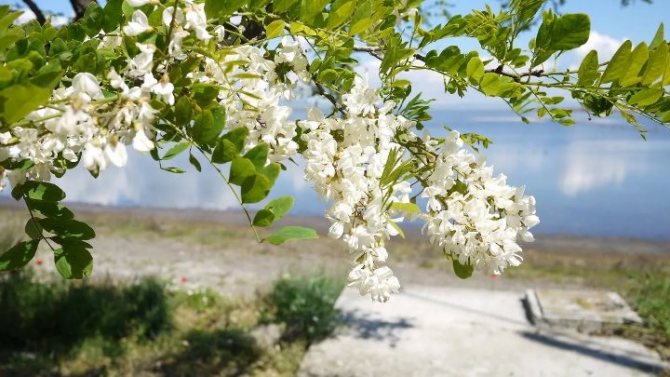

Features of growing bird cherry, how to care for a plant
The process of growing bird cherry is quite simple and straightforward, and also, which is equally important, does not take much time.
To obtain the desired result and fast growing of a tree, one should take into account not only the peculiarities of the region and the location of the land plot, but also recommendations regarding the comprehensive care of bird cherry.
How to water a plant
Watering should be carried out at the root of the tree, adding twice a month up to 20-30 liters of water for each plant.
In the driest weather, you can also additionally spray the tree leaves with clean water, thereby protecting them from drying out. Depending on the weather and temperature, it is allowed to increase or decrease the amount of irrigation without changing its frequency.
Rules for feeding bird cherry
Bird cherry, planting and caring for which rarely cause problems, sometimes also requires feeding. Fertilization of the tree is not necessary, but nevertheless it is it that allows you to prevent bird cherry diseases and extend its life, so most gardeners invariably resort to feeding.
It is noteworthy that mineral and organic fertilizers are suitable for bird cherry
... You can add them in spring and autumn, but you should take into account the seasonality. So, in the spring it is better to use saltpeter or urea, and in the fall, superphosphate and potassium salt.
Top dressing should be applied directly under the root, preventing fertilizer from getting on the leaves and young shoots. The concentration and volume of the applied top dressing should take into account the age and size of the tree, as well as the concentration of the substance. In this regard, you should unconditionally follow the recommendations on the fertilizer packaging.
Soil care
Caring for the soil on which the bird cherry grows is obvious and applicable to other trees. So, first of all, you should monitor the weeds, removing them in a timely manner. The soil needs to be loosened 1-2 times a season, avoiding cracks and constantly keeping it moist.
Varietal characteristics
The characteristics of the varieties of red-leaved bird cherry are in many respects similar. The most important parameters to look out for when choosing a variety are:
- frost resistance;
- yield and terms of fruiting;
- early maturity;
- self-fertility;
- resistance to pests and diseases.
Drought resistance, frost resistance
Red-leaved bird cherry is characterized by increased winter hardiness. It can be successfully grown even in regions where the temperature drops below 45-50 ° C during the winter months. Only immature seedlings need shelter. During a prolonged drought, bird cherry requires additional watering every 7-10 days. Normally, watering 3-4 times per season in the first year is sufficient.
Productivity and fruiting
The berries of the red-leaved bird cherry ripen in July and can be kept on the clusters until autumn. One tree, depending on the variety, can produce an average of 10-20 kg of berries. Fruits bake little in the sun, this happens only in a very hot dry summer. Unlike ordinary bird cherry, the berries of red-leaved varieties are larger and sweeter, without viscosity and sourness. They are used in cooking when preparing compotes, preserves, and various tinctures.
Disease and pest resistance
Red-leaved bird cherry can suffer from diseases such as:
- moniliosis;
- clasterosporium disease;
- cytosporosis;
- red spot.
Among the pests on the red-leaved bird cherry, you can often find aphids, bedbugs, hawthorn, weevils.
The degree of susceptibility to a particular disease depends on the specific variety and agricultural technology. Weak and emaciated plants are affected by pests many times more often than strong and healthy ones.
Advantages and disadvantages of varieties
Each variety has its own pros and cons. One variety was bred with an emphasis on frost resistance, another on yield, and the third on high decorative qualities.
| Variety | Dignity | disadvantages |
| Siberian beauty | High frost resistance, undemanding to the soil, high decorative effect, delicious sweet berries | The variety requires regular pruning, the yield is average, with the seed method of reproduction, varietal characteristics appear only in half of the seedlings |
| Red tent | Excellent taste of berries, high decorative effect, high immunity to most diseases and pests | Low flowering intensity, moderate resistance to heat and drought |
| Unkilled | Good frost resistance, high immunity to diseases, decorative effect | The variety requires regular pruning. |
| Chemal beauty | High decorativeness, large berries of dessert taste | The need to regularly treat pests |
How to propagate bird cherry in the garden
To obtain an acceptable result and further self-cultivation of this tree, you should know and understand how bird cherry reproduces.
Bird cherry propagation is possible in many ways: seed or vegetative (cuttings, layering, offspring, grafting). Each of them has proven itself positively and has shown high efficiency.
Seed propagation is more actively used for the species bird cherry. In this case, the seeds are mined by carefully opening the ripe fruit of the bird cherry, after which they are mixed with dry sand and stored in a cold place. Prepared seeds are sown in autumn or early spring in moist fertilized soil. Sowing depth 1-3 cm, depending on the looseness of the soil.
It is worth noting that seeds for spring sowing must be pre-stratified.
Stratification should be carried out within 3-4 months in moist peat, moss, sand or their mixture at temperatures from 0 to +5 ° C. The substrate should be kept moist throughout the entire time. Care for seedlings is simple and consists in timely watering, removing weeds and thinning at a distance of 5-10 cm. During the period of stratification, the plant manages to reach 40-50 cm in height, after which it can be planted in open ground in a permanent place.
For varietal bird cherry, budding with an eye is often used (carried out in the second half of July) and improved copulation (throughout the spring), while using seedlings of ordinary bird cherry as a stock.
Bird cherry should be planted when the weather allows planting - as soon as a stable temperature (over 10 ° C) and a constant level of humidity are established. In the spring, the planting of bird cherry in May is considered the most correct.
At the same time, it is important that the prepared planting pit is of sufficient size to accommodate the root system of the tree without kinks and bends. To improve growth, before planting bird cherry, mineral and organic fertilizers can be applied to the soil of the pit, but no more than 20-30 g each.
The distance between bird cherry seedlings is determined for each variety individually, however, as a rule, it should not be less than 3-4 meters. Before planting in the hole, the crown of the tree must be cut to 65-75 cm. During planting, the root system is covered with loose soil and, if available, with sawdust. From time to time, the trunk needs to be shaken, and the earth around it should be gently tamped. At the end, the bird cherry should be watered abundantly, and the moist soil should be mulched with a mixture of peat and sawdust.
Application in landscape design
Red-leaved bird cherry is suitable for both single and group plantings. It can be placed anywhere in the garden. In places for a quiet secluded pastime, where you can sit under a spreading crown, sheltered from the scorching sun. Bird cherry bushes and trees perfectly disguise an unsightly building or a rickety hedge.
Red-leaved bird cherry is often used to decorate forest islands, planted in the undergrowth or near the water. Many varieties of bird cherry are an integral part of a Russian-style garden, where culture is combined with plants such as:
- Birch;
- Rowan;
- irga;
- viburnum;
- rosehip;
- chubushnik;
- lilac;
- fruit trees and shrubs.
The red-leaved bird cherry is suitable for decorating alleys and as a hedge; its trunks that are bare with age are covered with a layer of decorative deciduous shrubs.
A warning! There is no need to put a bouquet with blooming bird cherry in the room - the phytoncides secreted by the plant can cause a severe headache.
The main pests and diseases of the plant
Bird cherry is an extremely unpretentious plant that firmly endures all the hardships and difficult climatic conditions of our region. In this regard, cases of bird cherry disease or damage by pests are recorded quite rarely. However, even in spite of this, experts identify the main types of pests and diseases that can affect this plant.
Among the main diseases of bird cherry are leaf spot, as well as fruit disease, which is caused by the marsupial fungus.
In the event of a plant disease, all affected areas of the tree should be immediately removed, and the cuts should be treated with garden varnish.
The most common pests are moths, silkworms, weevils, aphids, and other pests. To combat them in early spring, it is necessary to process bird cherry with concentrated tobacco infusion or soapy water. At the end of the flowering process, the plant should be treated again.
To improve flowering, it is advisable to spray the plant with a solution of component organic preparations "Decis" or "Sherpa".
Bird cherry is rightfully considered an excellent choice for planting on your own site. Along with a set of useful properties, this plant also has a pleasant appearance. Moreover, bird cherry, the cultivation and care of which does not require much trouble, can be planted on any soil, ennobling and fertilizing it.
To write a soulful article about a plant, you need to love it. This article will focus on the tree that I love immensely. This is the tree of my childhood.I remember the bloom of the bird cherry, its unique aroma, which notifies everyone that spring has taken over everything around. And, of course, the well-known lines of Yesenin sound in the head: "The fragrant bird cherry blossomed in spring and the branches are golden, that curls, curled ...".
Cherry cherry blossomed with spring
This tree grew with my grandmother, it grows with my parents, and when my husband and son and I have our own home, it will grow with us. White inflorescences of bird cherry delighted me in childhood, small, round, astringent black fruits, tart in taste, were a welcome treat on a summer day outside. And in the fall, a tall tree is covered with golden decorations.
Bird cherry properties - harm and benefit
Useful properties of bird cherry
Despite the fact that many of the medicinal properties of bird cherry have received their justification only today, various medicinal preparations have begun to make it from leaves and fruits for a long time. In folk medicine, they use bird cherry tinctures, decoctions and lotions from the plant.
What beneficial substances are contained in bird cherry, and what properties does it have? The composition of bird cherry berries includes pectins, tannins, sugars, organic acids. Its leaves, bark, flowers and seeds contain the glycoside amygdalin, which, when broken down, releases hydrocyanic acid. Essential oil, resin, flavonoids, phenolcarboxylic and ascorbic acids, gum and trimethylamine were found in fruits and foliage.
Bird cherry has astringent and antibacterial properties, therefore it is an effective remedy for diarrhea of any origin and other intestinal disorders. For these purposes, infusions of bird cherry are used.


The bark of bird cherry is used in folk medicine for the preparation of a diuretic decoction, which is used for kidney and heart diseases. This remedy, while also having a diaphoretic effect, helps in the fight against colds and fevers. A decoction of the bark is also effective for gastrointestinal spasms.
Tincture of bird cherry is used for washing the eyes with purulent conjunctivitis, for rinsing the mouth with stomatitis, throat for sore throat and diseases of the upper respiratory tract. It is also used in the fight against female diseases.
Planting bird cherry
Bird cherry, by and large, is unpretentious. I remember from childhood that in our village bird cherry grew in a wild state, and every year in May - early June, all trees without care and special soil fertility were strewn with flowers from top to bottom. However, many sources on the Internet write that you need to follow step-by-step planting guidelines.
Our bird cherry grew without additional fertilizing and in the shade and bloomed so that the whiteness of its flowers dazzled the eyes! But when compared with trees growing in the sun, ours was inferior in flowering, so choose a spacious sunny place for the bird cherry, plant a couple of trees, you can have different varieties, but so that they bloom together and can cross-pollinate. The distance between the seedlings should be not less than 5 m... Bird cherry is planted in spring and autumn.
It is better, of course, to choose a place with the occurrence of groundwater no closer than 1.5 m. Slightly acidic or neutral soil is loved by bird cherry. It grows on any soil, but loves loam.
Bird cherry
Dig a planting hole for a seedling so that its roots can easily fit in it. In the planting hole, along with the fertile soil layer, apply mineral and organic fertilizers according to the diagram on the package. It is better not to get carried away with organics, an excess of such fertilizers affects the bark. It darkens, thin branches may dry out.
After planting, water the seedling well and mulch the soil. Sawdust, peat, dry soil, at worst, are suitable for mulch. Water the plant several times during the growing season. In the subsequent period, watered if the summer is very hot.
What kind of soil does bird cherry love
With regard to soil, bird cherry has almost no special preferences.A hardy and self-sufficient tree, it grows quietly upward wherever it is planted. However, as with light, you need to be smart about it. Not all soil will allow the tree to express its beauty in its most vivid form. Firstly, the groundwater should be no deeper than one and a half meters from the surface of the earth, otherwise there will be problems with water - the tree will be withered and weak. Loam and its varieties are the most preferred soil for bird cherry, which has been repeatedly confirmed by many gardeners.
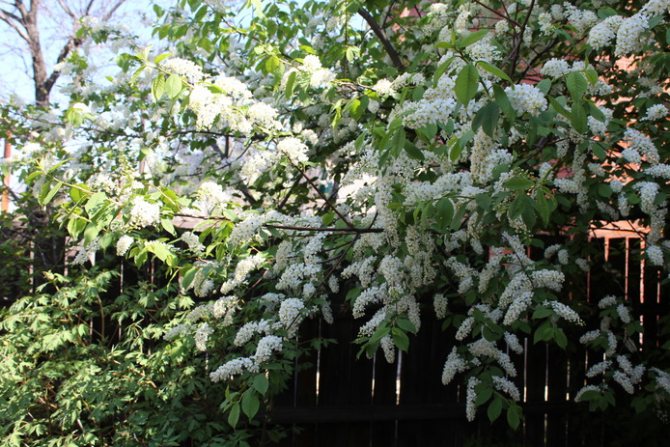

Bird cherry care
While the seedling is still a baby, it needs to loosen the soil, weed it, make formative and sanitary pruning. It can be formed in the form of a tree with a stem or in free form in the form of a shrub, but for the common bird cherry, due to its high size, the first option is better. Prune 50-60 cm of the main shoot each year to form a lush crown.
Due to the fact that bird cherry trees are quite tall, their crown often thickens, you need to constantly thin it out. I usually paint over what I cut with white paint. But you can cover it with garden var.
Bird cherry Maak is needed in stronger watering than ordinary bird cherry. Make sure that the ground is loose and at least slightly damp.
The bird cherry is adapted to our winters; it is not necessary to cover it in winter.
Read more about care in the video How to care for bird cherry?
How to properly prepare a planting hole for a seedling
Compared to many other trees, bird cherry is not particularly demanding on the conditions of its maintenance and planting. This also applies to the hole that is dug for the young tree. The main requirement that must be observed is that the pit must be large enough so that the roots of the tree can freely occupy all the space they need. Rotten and otherwise damaged roots must also be removed as they can cause disease in the plant. You can add fertilizer (again, too much in this aspect will only hurt), or even better, in addition to this, mulch the soil with sawdust. Such preparation will be quite sufficient for a young tree to start its life in a comfortable environment and does not feel any need for the nutrients it needs.
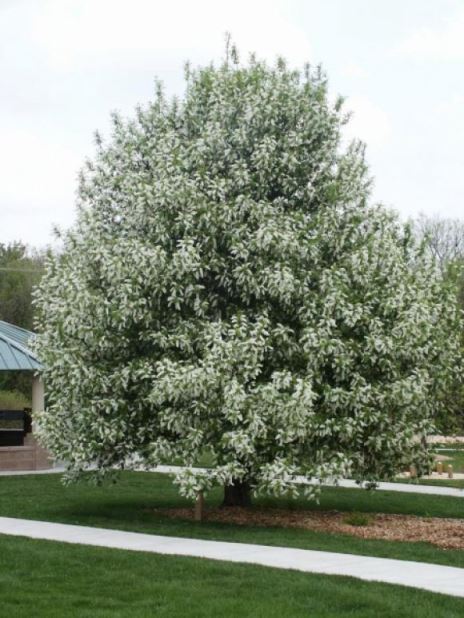

Types and varieties of bird cherry
The genus of bird cherry belongs to the extensive family of Rosaceae (Rosaceae). The bird cherry has about 20 natural wild-growing species, scattered from Western Europe to America. On the topic of bird cherry, to this day, disputes between Western botanists, referring it to the genus of plum, and Russian, shouting that bird cherry is a separate genus (Padus), which includes many species, do not subside. Today we are going to talk about those species that have been living in our country for centuries and are actively cultivated: bird cherry, Maak bird cherry, virgin bird cherry.
Bird cherry or carpal (Padus racemosa)
This is a tall tree (15-17 m) with a dark, black-brown matte bark, beautiful fragrant inflorescences in the form of tassels, which are so loved by the classics, me and many gardeners.
Bird cherry ordinary. Photo from the site wikimedia.org
It is its fruits that are knitting black drupes.
Bird cherry fruits. Photo from the site
Known forms of the common bird cherry species:
- Weeping (f.pendula)
- Terry (f.plena) - small flowers are collected in a brush from 10 to 13 cm
- Variegated (aucubaefolia)
- Rosy (roseiflora)
- Yellow-fruited (leucocarpa)
Bird cherry Maak
This species of bird cherry came to us in the middle lane from Khabarovsk and Vladivostok. The tree is about 13-15 m with golden-sandy bark in the light and greenish-olive in the shade. Flowers of this species are small, white, small tassels are collected in racemose inflorescences. They practically do not have a smell, very weak. The fruits are bitter and inedible, in contrast to the fruits of the common bird cherry. It is valued in the Far East as a good honey plant.Bird cherry of this species begins to bloom and bear fruit at the age of 7 years.
Bird cherry Maak. Photo from the site s019.
In Russia, they like to use this species in alley planting and gardening of streets. The frost resistance of the Maak bird cherry is very good, it is shade-tolerant, wind-tolerant, it tolerates urban conditions normally. It grows quickly, is little susceptible to diseases and pests. With Maximov cherry, the Maak bird cherry gives natural hybrids. Thanks to I.V. Michurin received an interspecific hybrid of Maak bird cherry and cherry - cerapadus.
Cerapadus. Photo from the site
Virginia bird cherry
It is the least common in the middle lane, but I touched on it, because by crossing it and the common bird cherry, excellent varieties were obtained, which I cannot ignore in my article. But about them at the very end.
Blooming virgin bird cherry
The Virginia bird cherry has a wide spreading crown, a dark brown bark with small cracks. White small flowers, about 1.2 cm, collected in small racemose inflorescences. The fruits are red and are eaten. From 7 years old it begins to bloom, by the end of summer the fruits ripen. Samovev and root shoots are common for this species. Despite the fact that this bird cherry is a resident of the forests of North America, in our culture it can be found on the Solovetsky Islands, Arkhangelsk and further in Ukraine in the Crimea. In our conditions, it can be found in the form of a shrub about 7 m high or in the form of a small tree
The fruits of the virgin bird cherry.
By crossing the common bird cherry with the Virginia bird cherry, varieties have been obtained that have large, tasty berries, good yield, resistance to diseases, such as Samoplodnaya, Siberian beauty, Black shine, Dawn.
Cherry variety "Samoplodnaya"
Our neighbors say that bird cherry is a breeding ground for pests and diseases, and so many gardeners believe, avoiding this tree in their area. I hasten to assure you: this is absolute nonsense!
Flowers and leaves of bird cherry secrete special substances that kill pathogens, mosquitoes and even ticks, while also purifying the air. For this reason, in the villages, people admire her on the street and do not bring flowers into the house, so as not to get a headache.
Discussion
I planted two different bird cherries near the entrance. I look forward to when they bloom. Elena Alexandrova: In our country house, behind the household block, the bird cherry has grown up to five meters. Flowering and smell somehow pass me by, once or it is cold for summer work. But all summer I am at war with the shoots, in the fall I sweep the fallen berries. But birds also get a lot of berries for the winter. Elena Morozova: I uprooted all the bird cherry. She is a breeding ground for all sorts of nasty insects (( Nadezhda Panova: Someone else is planting bird cherry? I can't get rid of her! Yes, it blooms beautifully and the berries are edible, but it is ready to take over the entire space with its roots, and powerful shoots, and branches that create shadow. Tatiana Allakhverdiyeva: Hope, I completely agree with you! And, also, she is a breeding ground for aphids. Natalia Pashkova: Tatyana, a breeding ground for aphids is an anthill))) Maybe she distracts this disaster on herself? Natalia Pashkova: People, I remembered anecdote. A foreigner asks the Russians - why is it so cold at the end of spring? - So the bird cherry blossoms - do not you see, or what? - Why are you planting her. P.S. I love bird cherry. And aroma and berries. And like many others, I associate it with childhood. But I'm not even going to plant it - there is a lot of it in the forest not far from us Margarita Anisimova: I love bird cherry, but I will not dare to plant it on the site. I have enough overgrowth from sea buckthorn, and from plum :-)). I planted a sand cherry: berries the size of a cherry, and the taste of bird cherry. Class. Vasilisa Difficult: Aphids, aphids, a lot of aphids ... I don't like bird cherry anymore. Better wild on the ravines of the narva)))
Please leave a comment
Description of red-leaved bird cherry
Bird cherry with red leaves is an ornamental culture that is loved by many gardeners both in Russia and abroad. The tree is distinguished by high growth rates, the average annual growth in height is about 1 m. Adult specimens reach 5-7 m. The crown of the red-leaved bird cherry has a pyramidal shape, but easily lends itself to decorative pruning.
The red-leaved bird cherry is often called the "chameleon tree" due to the unique characteristic of its leaves that change color during the summer season. In the spring, green leaves bloom on the branches, not differing in color from the rest of the trees in the garden. But at the end of June, the picture changes - the crown of the red-leaved bird cherry acquires a maroon or wine tint. The metamorphosis does not end there - new growths form green foliage. Thus, the tree takes on an even more decorative look.
During the flowering period, the red-leaved bird cherry is the dominant feature in the garden composition. Large (up to 15 cm), numerous inflorescences of snow-white or pinkish color with a tart heady aroma involuntarily attract attention.
The berries of the red-leaved bird cherry are almost 2 times larger than the common one, they have a sweet taste, they practically do not knit. The berries are easily separated from the branches, without emitting juice, hands do not get dirty.
Bird cherry is the most winter hardy of all stone fruit trees. Its wood can easily withstand temperatures as low as -50 ° C. The overwhelming number of varieties of red-leaved bird cherry can be grown in the conditions of central Russia, as well as in Siberia and the Urals. The most vulnerable time for red-leaved bird cherry is the period of loose buds and flowering. Frost damage can damage the ovary, which will significantly reduce the yield.
The red-leaved bird cherry belongs to cross-pollinated crops; for fruit setting, it needs the participation of insects and favorable weather conditions. When choosing a variety of red-leaved bird cherry, you need to pay attention to the flowering time: the farther north the growing region, the later the bird cherry should bloom.
Red-leaved bird cherry begins to bear fruit at the age of 3, an adult tree (7-8 years) can yield 20-40 kg per season, if spring and summer are rainy and cool - up to 12 kg.
Red-leaved bird cherry is unpretentious and can grow even on depleted dry soils. Its root system is resistant to the close occurrence of groundwater. The culture tolerates frost well, foliage is not susceptible to sunburn.
Description bird cherry Siberian beauty
The red-leaved bird cherry variety Siberian Beauty was obtained by Russian breeders from the National Research University Central Siberian Botanical Garden by crossing the common bird cherry and the Virginian variety Schubert. Included in the State Register in 2009, it is recommended for cultivation in all regions of the Russian Federation.
The plant has a dense pyramidal crown, grows up to 4-5 m in height. The color of young leaves is pale green, but with age, the upper part of the leaf plate acquires a dark purple hue, while the lower part acquires a light purple hue.
During the flowering period, which occurs in May, the tree is strewn with white cluster inflorescences, exuding a strong and sweet aroma. During maturation, green drupes change color to red, and subsequently to black. The taste of the berries is pleasant, low-tart, sweet. The average weight of the berry is 0.7 g, the yield indicators are average.
Advice! In order for the tree to actively bear fruit, experts recommend planting at least two plants on the site.
The bird cherry variety Siberian beauty prefers sunny areas, is distinguished by undemanding soil composition and very high winter hardiness. The variety is used both in single and in group compositions.
Description of bird cherry Tent
Red-leaved bird cherry variety Red tent is one of the decorative varieties.The tree does not exceed 4 m in height and width, the crown is formed in the form of a wide ellipse or egg, the density is average. The branches are bare, brown in color with numerous white lenticels, located at 90 ° to the main trunk, their tips are directed upwards. The bark is gray with a brownish tinge; slight peeling can be seen on the trunk. The leaf plates are oval with a pointed end; at the beginning of the growing season they are green, but by July they acquire a reddish-purple hue.
Red-leaved bird cherry of the Red Tent variety blooms in May with large white fragrant tassels. Ripe berries are black, with a characteristic glossy sheen, quite tasty. In terms of ripening, the variety belongs to medium-late, with sufficient pollination, it can be planted as food.
Bird cherry Red tent, according to the description of the Federal State Budgetary Institution "State Sort Commission", perfectly tolerates frosts and prolonged heat, but needs regular watering during a drought. The endurance gene grafted by breeders allows the variety to withstand attacks from harmful insects and not be exposed to the main diseases of stone fruit trees.
The Red Tent variety was included in the State Register of the Russian Federation in 2009 and is recommended for cultivation in all regions of the country. The authors of the variety were Russian scientists Ustyuzhanina T.B. and Simagin V.S., the originator is the Central Siberian Botanical Garden of the SB RAS.
Bird cherry
The variety of red-leaved bird cherry Neubiennaya is a tall shrub or tree up to 7 m high. The branches are dark brown, the foliage is dense. The crown has the shape of an oval, formed by erect large shoots. Blooms in May with white, fragrant inflorescences in the form of brushes. By mid-July, the leaves begin to turn red and after 2 weeks they acquire a deep inky-plum shade. Even numerous photos of the bird cherry Neubiennaya cannot convey this rich noble color. This variety of red-leaved bird cherry is distinguished by good frost resistance, diseases and pests are rarely affected.
Comment! The name of this variety of red-leaved bird cherry is associated with the date of the execution of the last Russian emperor Nicholas II - from July 16-17, its foliage begins to dramatically change in color, sometimes acquiring a bloody hue.
Bird cherry Chemal beauty
The variety was bred in the mountainous regions of Altai, in NIISS (Chemal village). The tree is vigorous (4-10 m), characterized by a crimson shade of leaves. Blooms in May with pale pink inflorescences, abundantly, but not for long. Fruits in a mature form are black, weighing up to 0.8 g. According to gardeners, bird cherry Chemal beauty has a rich dessert taste. The plant grows well on fertile soil with excessive or flowing moisture. In early spring, before bud break, it needs treatment from pests and possible diseases.
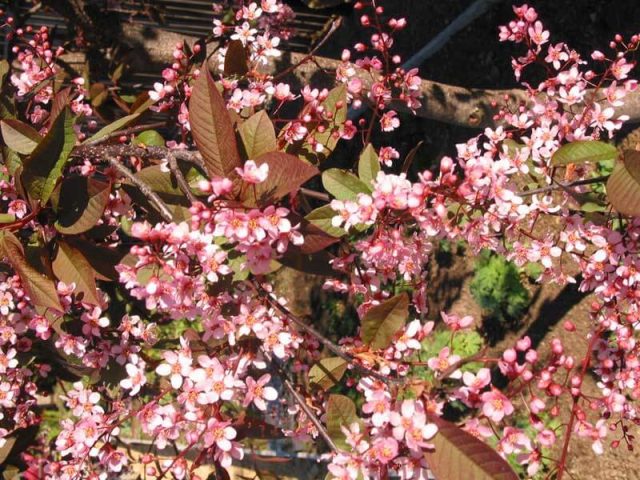

Contraindications
Before using medicines, which include common bird cherry, the photo of which you can see in this article, you need to consult a specialist. It must also be remembered that these drugs are among those whose dosage and rules for taking must be followed.
This is due to the fact that the branches, bark, flowers and leaves of this plant contain the substance amygdalin glycoside. It is able to break down into glucose and hydrocyanic acid as soon as it enters the human body. Especially with an overdose of the latter, severe intoxication occurs. However, in a small amount, hydrocyanic acid cannot cause any harm to the body. In addition, all preparations from bird cherry are completely contraindicated both during pregnancy and at the stage of lactation.
Bird cherry Antipka
This is a shrub form of bird cherry with a powerful root system, lives up to two hundred years. The plant is unpretentious, adapts to different soils, can even grow on a rocky slope. The native land of the species is the Middle East and Europe.The plant is very valuable because it can be used as a rootstock for cherry and plum trees. The shrub is most often grown to strengthen the slope. Antipka bird cherry inflorescences are small white in color, have a pleasant aroma. The fruits are small, blackish in color.


Photo gallery
In addition to varieties of plants with edible berries, decorative forms of bird cherry have also been developed, which are used exclusively for the purpose of decorating garden flower arrangements in the field of landscape design.
These include the forms of bird cherry, a photo and a brief description of which is given below:
Photo gallery
Popular is Cerapadus - a hybrid obtained by crossing the Maak bird cherry and Maximov cherry.
Having an idea of the appearance, purpose and characteristics of the species common in Russia and the varieties of bird cherry bred within them, it is easy to navigate when choosing a tree for your personal plot.
Bird cherry Magalebskaya
The tree is widespread in Europe, in the southern regions, where it was given the names "antipaka", "magalebka" and "magalepka". In England, this bird cherry is called the Saint Lucie cherry. It develops in height up to 10 meters with a width of about 8 meters. The leaves of the tree are rounded, up to 6 cm long. The flowers are snow-white in color, have a pleasant aroma, collected in brushes in the form of a shield. The tree blooms from the middle to the end of spring. Fruits are small in size, black in color, bitter in taste. The bird cherry blossoms and bears fruit 3-4 years after planting. The plant is resistant to extreme heat and droughts, to low temperatures, tolerates winters at -25 ... -27 ° C. Will grow well in a bright open place on fertile soil. Seed propagation method. The tree is long-lived, grown to create hedges. Pruning is good for growth and shape.
Red-leaved bird cherry in all its glory
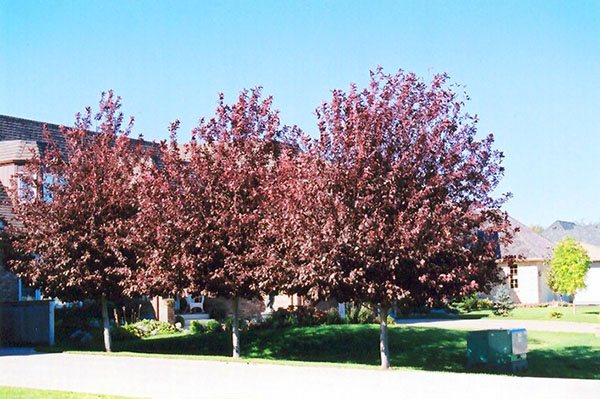

White crow allows you to imagine a vivid contrast of something that stands out against a gray background. Likewise, the purple-leafed bird cherry attracts special attention. The plant is often referred to as a "chameleon" for its ability to change leaf color throughout the season. In early spring, the plates are no different from other trees on the site. However, in early July, an original metamorphosis occurs. The pyramidal crown of the red-leaved bird cherry acquires a purple hue, and it becomes the queen of the garden. The tree lives for about 70 years. The maximum height of an adult culture is approximately 7 m.
The plant grows about 1 m in height per year. Due to this, it is actively used to form exotic landscapes.
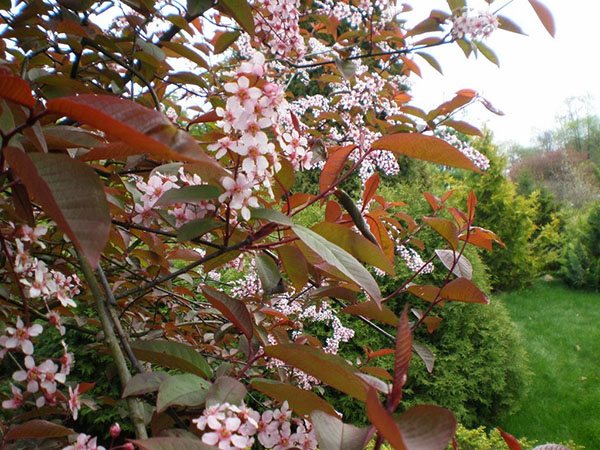

During the flowering period, the bird cherry wears a chic outfit of many snow-white or pinkish buds. Some of them are about 15 cm in diameter. They exude a heady scent that creates an aura of bliss around them.


Large cherry berries with red leaves have a sweet taste. They can be easily removed from the branches. Due to the strong skin, the fruits do not produce juice, so they can be stored for several days. Used in folk medicine. The first fruits appear already in the third year after planting. During the season, from 20 to 40 kg of berries are harvested from an adult tree.
The culture has a stable root system. Thanks to this, it will successfully grow even on dry and depleted soil. Wonderfully tolerates winter cold and summer heat. There are many varieties that adorn the gardens of our compatriots. Let's get acquainted with some of them.
Gorgeous Siberian beauty


The plant grows to about 5 m in height. Has a lush pyramidal crown shape. The young foliage of the bird cherry is painted in a pale green color. With age, it becomes a deep purple color. The lower part of the plate has a light purple hue.
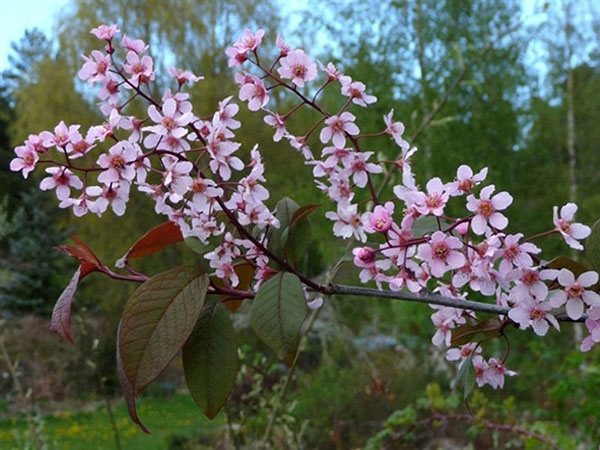

When the flowering period begins, many snow-white bouquets appear on the Siberian beauty.During this period, there is a strong scent around the tree, which attracts hundreds of insects. Over time, small fruits are tied. First, they are colored green, then red, and when ripe they become black. The red-leaved bird cherry Siberian beauty depicted in the photo evokes the admiration of many gardeners.
If you plant several such plants on the site, you can significantly increase the yield of the crop.
Exquisite Red Tent
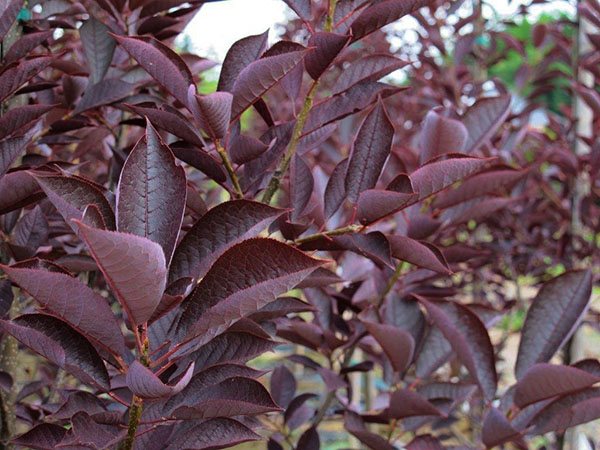

The variety is a tree, about 4 m high with an elliptical crown. In early spring, green oval leaves bloom on it. By the middle of summer, they become purple in color. The Red Tent blooms in May with lush fragrant tassels. Black ripe fruits are covered with a glossy skin and have a pleasant taste. The culture miraculously endures summer heat and winter frosts.
Her Majesty the bird cherry Unkilled
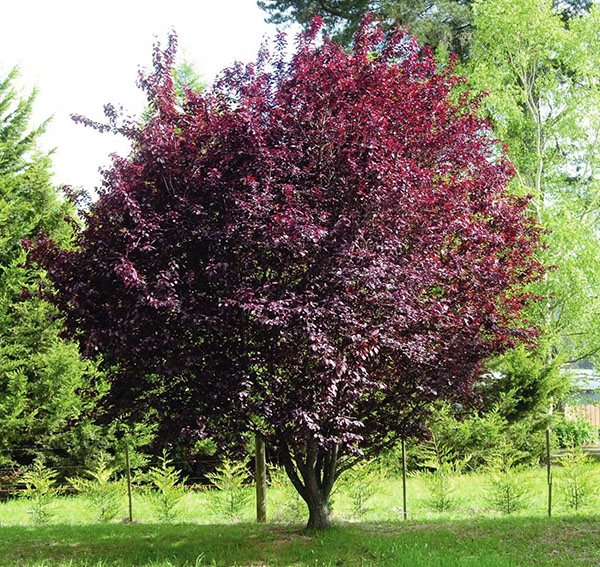

The variety belongs to tall crops and reaches 7 m in height. The shoots of the plant are covered with dense foliage and are colored dark brown. They form an oval crown, which, during flowering, wears a snow-white outfit of fragrant tassels.
In mid-July, the foliage completely changes its color. At first, it turns red, and then turns into a rich plum shade.
Interestingly, the culture got its name in honor of the last emperor of Russia, who was executed in the middle of summer. It was at this time that the leaves of the bird cherry turn a blood red color.
Having considered the detailed description of the red-leaved bird cherry, wouldn't you want to grow such a plant in your own country? Let's figure out how to bring the dream to life.
Description of bird cherry: what the tree looks like, and what berries it has
Bird cherry grows in the form of a tree or a large shrub, belongs to Rosaceae. The average plant height often reaches about 6 m, and the maximum - up to 15-17 m.
The description of the bird cherry trunk is as follows: it often has a curved (arched) shape with an inclination to the ground. The diameter is often about 0.4 m. The bark, which it is covered with, has a dark brown tint, matte, slightly cracked, dotted with brown and rusty spots on the surface. If the branches are still young, then they are covered with a shiny, partially pubescent bark, on which you can observe elongated lentils, which have a whitish tint and a strong bitter odor.
The leaves of the bird cherry are endowed with an obovate shape. Their length can be from 6 to 25 cm, width - about 7 cm, petioles - from 1 to 4 cm long. The color of the leaves depends on their age: the old ones have a dull green tint, and the young ones are greenish-golden.
After looking at what the leaves of the bird cherry tree look like in the photo, you will be convinced of the accuracy of the above description:
Photo gallery
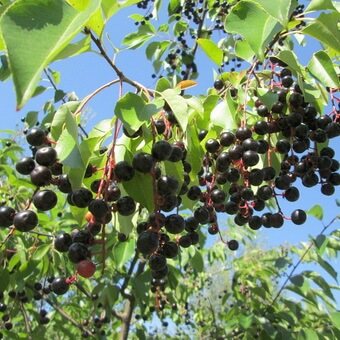

Late: The species got its name due to the late appearance of the color - in the last days of May. The flowers are white and do not exude any scent. Trees prefer rich soil. They grow at a rapid pace up to 20 m in height, have a spreading crown. Well pruned, frost-resistant. This is a general description of late bird cherry of such varieties as Plotnokistnaya, Samoplodnaya, Sakhalin Resistant, etc. They give black edible berries with a bitter taste. The decorative forms of the plant are variegated, pyramidal, weeping, gristly, willow, terry.
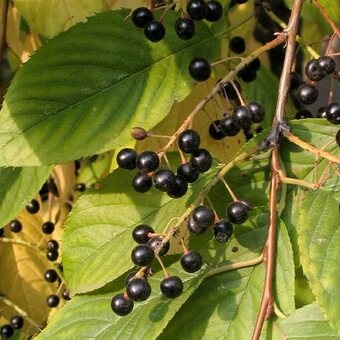

Maaka: all forms and varieties of bird cherry of this species are decorative and produce inedible berries, which birds and bears prefer to feast on. The fruits are very small and black in color. Plants have a maximum height of about 7 m, they like open areas, are resistant to dry climates. Their crown is pyramidal, the color is white and odorless, the brushes are oblong. Thanks to these features, bird cherry is one of the most beautiful. Used in urban landscaping.
Estimate in the photo how unusual some varieties and forms of bird cherry of the Maak species look in tandem with conifers:
Photo gallery
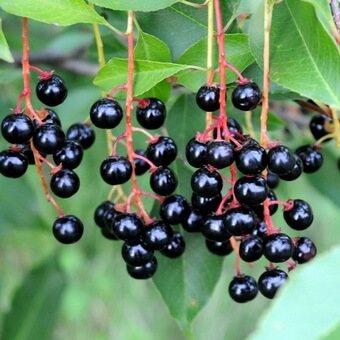

Dawn: bred by breeders in Siberia. Therefore, the main feature of the plant is a very high level of resistance to severe winters. The tree grows short - its maximum height is 3 m, in this regard, it is quite convenient to harvest from it. It is also edible bird cherry, the fruits of the Rassvet variety are black, sour-sweet, with a slight hint of astringency. In terms of ripening, the culture belongs to a number of early ones.
You can see how the plant and its berries look in the photos presented to your attention:
Beneficial features
Bird cherry, the photo of which is presented in this article, is a medicinal plant. It has a sedative, diaphoretic, diuretic, astringent, tonic, anti-inflammatory, hemostatic and anti-scurvy properties. This plant is used almost entirely, including leaves, fruits, bark and flowers, all due to its chemical composition. So, the following active substances were found in bird cherry:
- a large amount of vitamins;
- organic acids;
- flavonoids;
- glycosides;
- phytoncides;
- anthocyanins;
- fixed oils;
- rutin;
- saccharides;
- various trace elements;
- tannins.
In addition to the above elements, bird cherry also has quite rare components. These include free hydrocyanic acid and benzene aldehyde. For the manufacture of medicines, the fruits of the plant are most often used because of the tannins they contain, as well as citric and malic organic acids. They are highly regarded for their astringent and anti-inflammatory properties. In addition, they can normalize the functioning of the intestines and stomach.


Types of growing bird cherry
When growing bird cherry, several methods are used: using seeds or seeds, cuttings, shoots or layering. The first method is often used, but the distinctive features of the mother tree in the seedling will not be preserved.
When growing bird cherry from a stone, it is necessary to check whether the seed is suitable for germination. This can be done in the following way: take a glass of water and place the seed there. If it sank to the bottom, then it is suitable for germination.
Photo gallery
In addition to diseases, bird cherry is also affected by pests, the most common of which are the following insects:
- sap-eating plants (bug, coccidus, leaf flea);
- eating leaves (butterfly caterpillar, sawfly larva, leaf beetle, bird cherry moth);
- miners growing inside the leaf;
- galls (felt and gall mites);
- intra-stem pests (bark beetle, woodworm).
To exterminate insects, you need to treat the plant twice with karbofos or kinmix. If the tree is very heavily infested, a third treatment may be necessary.
For young seedlings, it is recommended to give preference to folk rather than chemical means: spraying with a solution of soap and tobacco infusion. Such treatment is also suitable as a prevention of the appearance of pests - in early spring and after the color has fallen.
Bird cherry can become a decoration of any garden and a source of medicinal and tasty fruits, without requiring painstaking care. The main thing is to adhere to the basic recommendations, and difficulties can be avoided.
"Dense"
The variety is a medium-sized tree up to 4.5 m with a gray rough trunk and upward thin shoots of light brown shades. The leaves are small in the form of an elongated green oval.
White buds, very densely arranged in inflorescences, up to 40 units in total. Fruits are flat-round in shape with a black surface and yellow juicy pulp. On very ripe specimens, burgundy veins are visible inside.
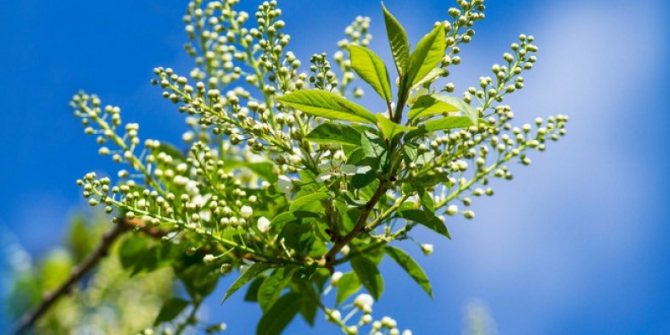

In terms of taste, bird cherry berries are rated for 4.4 points, have a sweet-sour tart taste. Suitable for raw consumption, drying and home canning.
The plant is characterized by high cold resistance, resistance to aphid attacks and stable fruiting. Among the negative differences of the variety is high sensitivity to hawthorn and bird cherry elephantsas well as poor rooting of cuttings.
Features of the
Low-growing trees or bush bird cherries are classified as ornamental plants. She is surprisingly unpretentious, lives not only in our country, but also in the countries of Central Asia, Korea, Japan and even beyond the Arctic Circle. In the wild, bird cherry grows along the banks of forest rivers and lakes, and in urban culture, it is planted in parks and household plots.
What a mesmerizing sight it is: a tree covered with delicate white flowers, exuding an incomparable aroma. How many poems were composed about him, how many songs. And how many signs are associated with this small tree. The most famous: the bird cherry blossomed - wait for a cold snap. The omen always comes true, with rare exceptions. However, biologists say that bird cherry needs coolness to bloom and it adjusts itself to weather conditions. Even if a cold snap did not come during flowering, this will happen in the coming days.
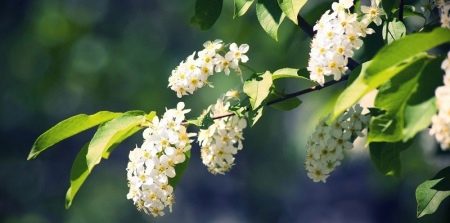

Abundant flowering foreshadows a cold rainy summer, and if the bird cherry blossoms early and blooms for a long time, summer will delight you with warm sunny days. Bird cherry blossoms for a long time - the summer will be hot, and the harvest will be rich.
It is not without superstition: for a long time bird cherry was not planted near residential buildings, considering it an unfavorable sign for family relations. Today, prejudices are a thing of the past and gardeners are happy to place bird cherry on their plots in order to enjoy the delicate aroma of flowers in spring, and to collect tart fruits in autumn. Let's take a look at the appearance of this wonderful plant.
Description of popular varieties of bird cherry for growing in the garden (with photo)
Bird cherry in the garden is always appropriate: in spring it hides behind a thick cloud of fragrant petals, in summer it beckons with fruits, in autumn it dresses up in purple-crimson foliage and even in winter does not lose its decorative effect. For several years, breeders have improved the basic plant species, conjuring up new cultivated varieties. The characteristics and main differences of the best hybrids will be discussed further.
With age, they acquire a bronze tint. The berries are medium-sized, black, attached on red petioles, sweet on the palate, slightly tart. Ripen in early August. The rhizome is dense, located mainly in the upper layers of the soil.
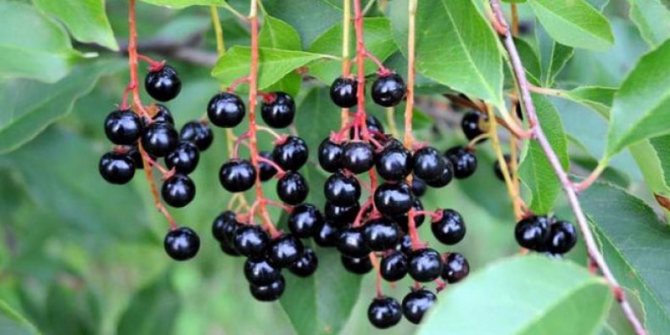

When the trunk is cut, root processes are formed, which soon give rise to dense growth. The plant develops rapidly until the age of five, and then stops growing.
The Colorata variety is characterized by shade tolerance, but still prefers sunny areas, and once in the shade, it stops blooming and loses its purple tones on the foliage. The plant loves moisture and fertile substrates.
Photo gallery
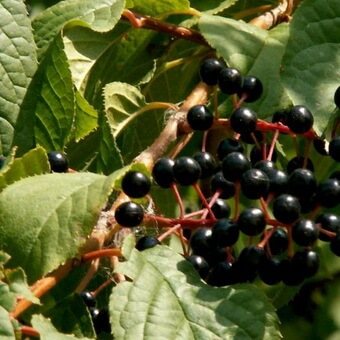

In memory of Salamatov: the tree is famous for its frost resistance, early ripening of fruits and high yields. One adult plant is capable of providing about 40-45 kg of berries with an average weight of up to 1 g each. The cherry fruits of the Pamyati Salamatov variety are tasty, honeyed, without a single hint of astringency. Pay attention to the images and note for yourself how they look on the green tree.
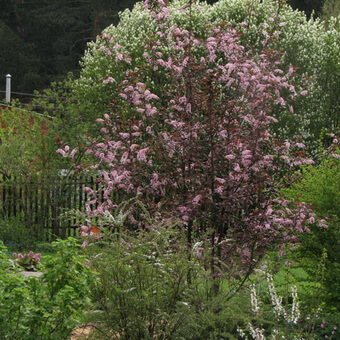

Colorata: this variety is known for its openwork rounded crown, dotted with purple leaves, which tend to change shade to green-brown, and pink with a heady almond aroma. The plant can grow both in the form of a shrub and in the form of a tree about 7 m high. It has a high level of frost resistance. Ripening of berries occurs in the first decade of August. Fruits are small, colored black, sweet to taste, but with a slight tinge of astringency.
Study the clearly presented characteristics and description of the Colorata bird cherry variety in the photo:
What is new among the traditional varieties of bird cherry?
Usually, among the cultivated varieties of garden bird cherry, there are three main types:
- Common bird cherry - this species blooms quite luxuriantly and gives abundant harvests;
- Virginskaya - has a later flowering period and gives more stable berry yields;
- Late bird cherry - differs from the previous ones in that the fruits ripen exactly one month later.
Read also: Features of growing wisteria in the garden
But the years of work of breeders, conjuring over the main types of bird cherry and cultivated varieties of cherries, made it possible to bring out the most popular varieties. Their main distinguishing features are resistance to various diseases and pests, as well as the absolute absence of astringent and astringent taste. In addition, they managed to significantly enlarge the fruits.
Pruning bird cherry in spring and autumn
Another aspect of plant care is periodic pruning.
For bird cherry, it can be formative and rejuvenating (or sanitary):
- The first is performed with the aim of forming the crown of the plant in spring or autumn. It should be started immediately after planting the seedling in the ground. As mentioned above, the tree is cut to a height of 50-70 cm. This will contribute to the establishment of skeletal branches of the first tier - it is necessary to leave no more than 4 well-developed lateral shoots, located at an even distance from each other. After a year, the plant will need to be cut at a height of 50 to 70 cm from the level of the first tier of the main branches in order to enable the second to form. According to this principle, the tree is cut in the third year after planting to form the third tier.
- The second type of pruning bird cherry is performed in the fall for mature adult plants annually. On the crown, those branches are removed that are withered, diseased or broken. In the places of the cuts, a garden pitch is applied.
Virginia
Virginia bird cherry (Padus virginiana) is especially popular in Europe. It spread from North America, where it grows on the shores of rivers and lakes. According to the description, the species is close to the ordinary culture we are accustomed to.
The fruiting phase begins at the age of 7. The unharvested crop dries up and remains on the stalks until the next flowering. In care, it requires regular moisture in the heat, has high resistance to frost, drought and harmful bacteria, pests.


Adapts to shade, but grows better in well-lit areas. Has many forms, among which deserve attention ‘Schubert’, ‘Atropurpurea’, ‘Wilpert’, ‘Leucocarpa’.
Transplanting bird cherry in the spring and preparing the site in the fall
Another important issue that requires attention is the transplanting of a bird cherry tree or bush from one place on the site to another. This procedure is recommended to be performed in early spring, but preparation for it should begin in late autumn.
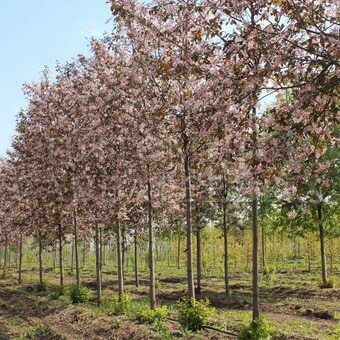

First, you need to dig a hole of the required size, leave it until spring so that the soil settles.
When the thermometer drops to +5? C, and this air temperature stabilizes, it is necessary to dig around the trunk of the plant, which is planned to be transplanted in the spring, water it abundantly so that the rhizome goes into a state of winter calm in the frozen soil.
Upon the arrival of spring, care must be taken to ensure that the lump of soil does not thaw too quickly. For this, the soil is covered with snow, which is still left, burlap and sawdust are laid on top.
A bird cherry transplant, prepared in the fall, is done when the snow has completely melted. The plant is dug out so as not to hurt the rhizome, moved with a lump of earth into a pit for planting. So that the soil does not crumble, it is better to sprinkle the roots with water and tie them with burlap. You don't even need to remove it when planting - it will not become an obstacle to the growth of the root system, and at the necessary moment it will disintegrate itself.


Next, you need to fix the transplanted plant with wire ties to the stakes placed next to it. So that the metal does not touch the trunk, they make a lining of cardboard, fabric, birch bark.
So that the transplanted tree or bush does not die, it is necessary to create a shade for them, it is worth watering the plants with the addition of a root development stimulator.
Diseases and pests of bird cherry leaves: photos, names and treatment of plants
This plant, in comparison with many fruit and berry crops, is distinguished by a high level of resistance to the development of diseases and the attack of pests. Nevertheless, it is necessary to know which bird cherry diseases threaten, and what the treatment consists of.
Pockets of berries and colors: the key reason for the occurrence is waterlogging, and the main symptom is a change in the color of the fruit to brown, the shape to an elongated one with a pointed apex in the absence of seeds. The outer surface of the berries is covered with a bloom, which consists of bags of pathogenic fungi. If the disease affects the color, then the fruits are not tied at all. To exterminate the fungus, it is necessary to destroy the affected berries, and then - the treatment of the plant with medicinal preparations. As a preventive measure, it is necessary to treat the bird cherry with such a remedy even before the buds bloom - at the beginning of spring.
Powdery mildew: also a fungal disease that affects the leaves. The main symptom is the appearance on their surface of a plaque in the form of a whitish cobweb. It is necessary to remove and destroy all the foliage that has fallen, and spray the plant itself with foundation or Bordeaux mixture - 2-3 times during the summer.
Red spot: the appearance of this leaf disease in bird cherry is evidenced by large red spots on both sides of the leaf. With the arrival of autumn, they become brown and cause premature leaf fall in the plant. Treatment is the same as for powdery mildew.
Cercosporosis: due to a too humid summer, micro-necroses of white-gray color appear on the front surface of the leaves, and brown on the back. When the disease progresses, individual spots combine into one, and the affected area simply falls out. Treatment is the same as powdery mildew and red spot.
Rust: medium-sized pustules of a brown-red color appear on the leaves, and with the onset of autumn, they are supplemented by the appearance of purple and crimson pustules. Infection of foliage occurs during the growing season. The affected plant must be treated with vitriol, also sprinkled nearby growing spruces (breeding grounds of the fungus), and their cones must be destroyed.
Cytosporosis: develops on foliage, trunk, branches, leads to complete drying out. The main symptom is the emergence of small bumpy growths, from which red threads emerge under wet weather conditions. It is necessary to cut off the affected areas, clean the places where the fungi are concentrated and rinse with a solution of copper and soap, disinfect and process with garden varnish.
Wood rot: the cause is the penetration and reproduction of fungi in the wood (for example, through broken branches), and the consequence is the premature aging and death of plants. The affected plant must be uprooted as soon as possible, and the hole must be burned out.
See how the signs of the bird cherry diseases described above look in the photo with the names, in order to be able to recognize the problem in a timely manner in the future:
Folk omens associated with the flowering of bird cherry
The tree blooms in May or early June. Flowers collected in oblong inflorescences smell good and attract bees. Bird cherry is a wonderful honey plant. This is another reason why they tried to plant near houses or in personal plots. The tree or shrub is widespread throughout Russia: from the European part to Siberia and the Far East... That is why, along with the birch, it can be considered a symbol of the Central Russian Plain.


Bird cherry in bloom
The most common type of bird cherry is ordinary, it is also called carpal. She throws out brushes of white inflorescences. Of the 20 varieties of wood, 7 are cultivated on our territory.... Of these, decorative species stand out. Their unusually beautiful inflorescences, from yellowish multi-colored to double pink, are used in landscape design to decorate garden and park compositions and personal plots.
But for most people, the fragrant bloom symbolizes the renewal of nature and the optimistic spring mood.
Photo gallery
The plant has a dense and wide crown, drooping branches. The buds that emerge in spring are covered with scales arranged in a tiled manner. Their shape is conical, narrow, the length is about 12-13 cm, pubescence on the kidneys is absent.
Bird cherry flowers appear in the last week of May and remain on the tree during the first 10 days of June. They are small in size, have a strong fragrant aroma, are painted in white, red, pink (depending on the variety). They are collected in beautiful drooping brushes, like branches, of a type about 12 cm long.
Appreciate the beauty of the abundant color of different varieties of bird cherry in the photo below:

